PERFORMANCE STUDY GUIDE
GRADES K—3
Alabama Symphony Orchestra
Peter and the Wolf
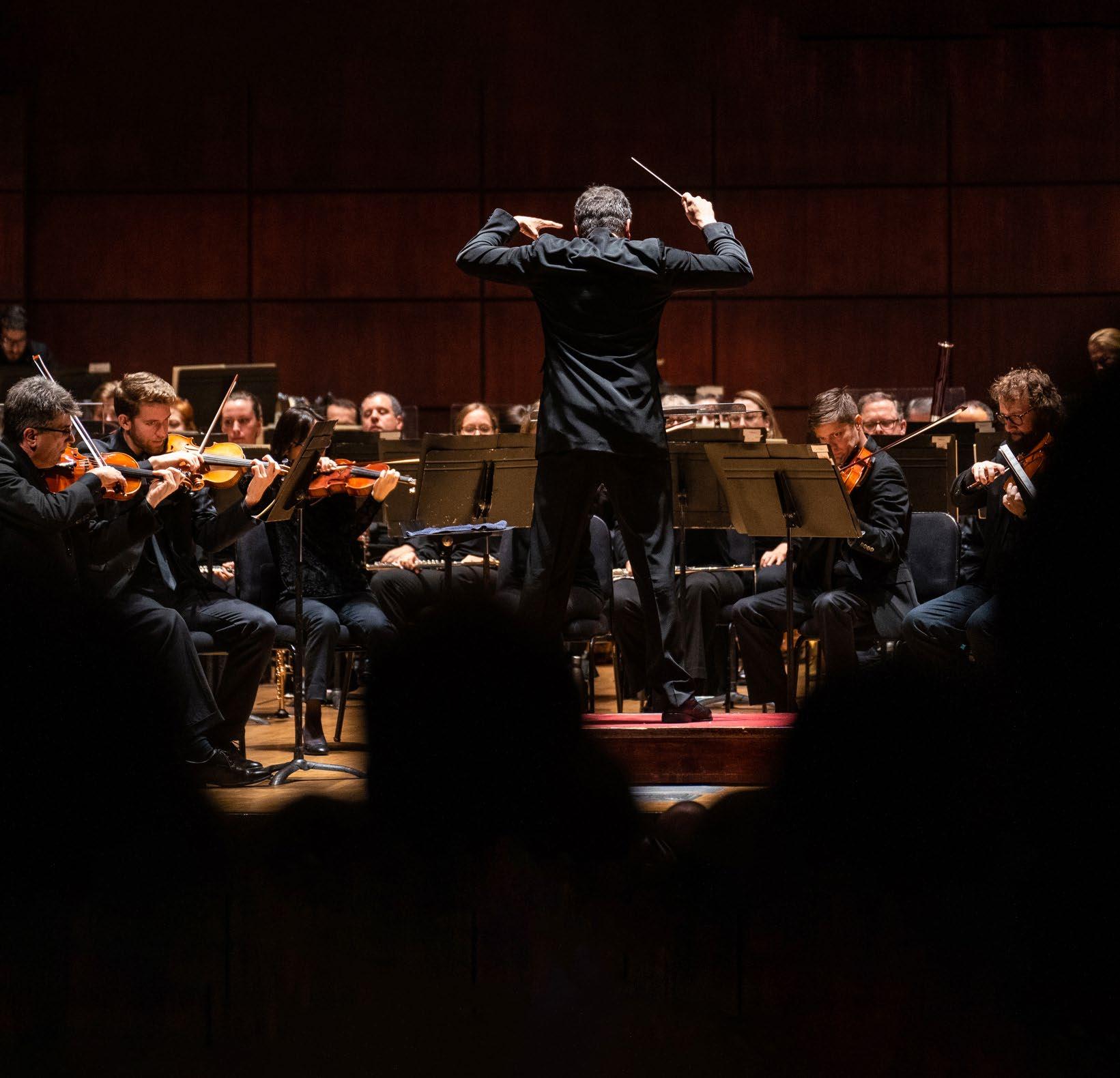
The Jay and Susie Gogue Performing Arts Center at Auburn University engages audiences across the university, the state of Alabama and beyond with curated arts experiences that inspire, enlighten and unite.
Our annual K–12 School Performance Series provides opportunities for students to enjoy exclusive performances by some of the most talented and accomplished artists from around the world. Prior to each K–12 school performance, teachers receive a learning guide containing details about the performance, artist and company, supplemental information about the art form and its history, and grade-appropriate activities designed to spark conversation and exploration in the classroom.
To learn more about education and engagement initiatives at the Gogue Center, visit goguecenter.auburn.edu/education.
produced
by Jay and Susie Gogue Performing Arts Center at Auburn University
910 South College Street
Auburn, Alabama 36849
k–12 school performance series contact Andrea Jarmon, D.M.A.
Education Coordinator
telephone: 334.844.7371 email: gpac_education@auburn.edu
2
© 2023 Auburn University
Alabama Symphony Orchestra Peter and the Wolf
PERFORMANCE STUDY GUIDE
GRADES K—3
 Alabama Symphony Orchestra
Alabama Symphony Orchestra
Table of contents Where will we go? 7 Going to the Gogue Center ¦ 7 Who Will You See Here? ¦ 7 What Does the Audience Do? ¦ 7 Acoustics: The Science of Sound ¦ 9 Who to know at the show 10 Composer Sergei Prokofiev ¦ 10 Alabama Symphony Orchestra ¦ 10 Conductor Mark Alpízar ¦ 10 What to know before the show 12 Orchestral Instruments & Their Families ¦ 12 Instruments in Peter and the Wolf ¦ 14 Fairy Tales ¦ 18 Cause & Effect: Character Education ¦ 19 ACTIVITIES Musical Instrument Families 20 worksheet: Whose Sound is That? Music & Abstract Art 24 Fairy Tales & Folktales 26 worksheet: What Happened? Cause & Effect 28 Peter and the Wolf ¦ 30 worksheet: Mood Journal worksheet: Actions & Consequences Why we go to the show 35 Alabama Wildlife ¦ 35 Birds of Alabama ¦ 36 Birds & Their Beaks ¦ 37 Which Came First: The Chicken or the Egg? ¦ 37 ACTIVITIES Alabama Wildlife 38 worksheet: Have You Seen Me? worksheet: Fill the Bill What to do after the show 44 worksheet: My Trip to the Gogue Center worksheet: Who's Who: Peter and the Wolf Online resources 48
 The Jay and Susie Gogue Performing Arts Center at Auburn University
The Jay and Susie Gogue Performing Arts Center at Auburn University
Where will we go?
GOING TO THE GOGUE CENTER
The Jay and Susie Gogue Performing Arts Center, otherwise known as the Gogue Center, is located on the campus of Auburn University in Auburn, Alabama.
The Gogue Center houses the 1,200-seat Woltosz Theatre. The theatre was built with exceptional acoustics so that it is possible to hear well from every seat.
What Does the Audience Do?
Alabama Course of Study
GMu3-5.15 GMu6-8.14
National Standards
MU:Pr6.1.3-8b
The audience is an important part of the performance. Without the audience, who would watch the performers? Who would clap and sing along and appreciate what the artists bring to the stage? When you are a member of an audience at the theatre, there are a few things to know about what to do and what not to do.
WHO WILL YOU SEE HERE?
Ushers
These are the people who will greet your bus, lead your class into the building and help you find your seat. Be sure to say “hello!”
Stage Crew
These are the people who work backstage, so you won’t see them in the lobby, but you might see them before or after the performance, and sometimes, they even come on stage during the performance to move things.
Lighting & Sound Operators
These are the people who control the lighting and the sound for the performance. You may see them in the middle of the auditorium at the big sound board or in the back of the auditorium in the booth. Sometimes, the spotlight operators are in the back way above your head.
Performers
These are the people on the stage who may be dancers, musicians, singers, actors or acrobats. It is their job to communicate using their bodies, instruments and voices.
Audience Members
This includes you, your classmates, and other students and teachers from around the state of Alabama and maybe even Georgia.
Sit in your seat and look around, but please keep your feet toward the ground.
Listen and watch, but do not talk.
Have a camera or phone? Please turn it off.
The performers will take to the stage, and we know they will engage. You can laugh, you can sing, you can get up and dance, but just make sure that you give them all a chance!
THANK YOU! BRAVO!
When the song is done, or the show comes to an end, make sure that you give the performers a hand! Applause is the way that we can say thank you for all that they did today!
7
 Walter Stanley and Virginia Katharyne Evans Woltosz Theatre
Walter Stanley and Virginia Katharyne Evans Woltosz Theatre
Acoustics: The Science of Sound
Alabama Course of Study Standards
SC1.1
National Standards
NS.K-4.1 NS.5-8.2
Acoustics is the study of sound and how that sound reacts in spaces, particularly rooms and buildings. What is sound? Sound is vibration. That vibration travels through the air and into our ears where we hear it.
Vibration begins through movement—for example, strumming a guitar string. That vibration creates a sound wave. In a theatre or concert hall, acoustics are important so that everyone can hear the performers.
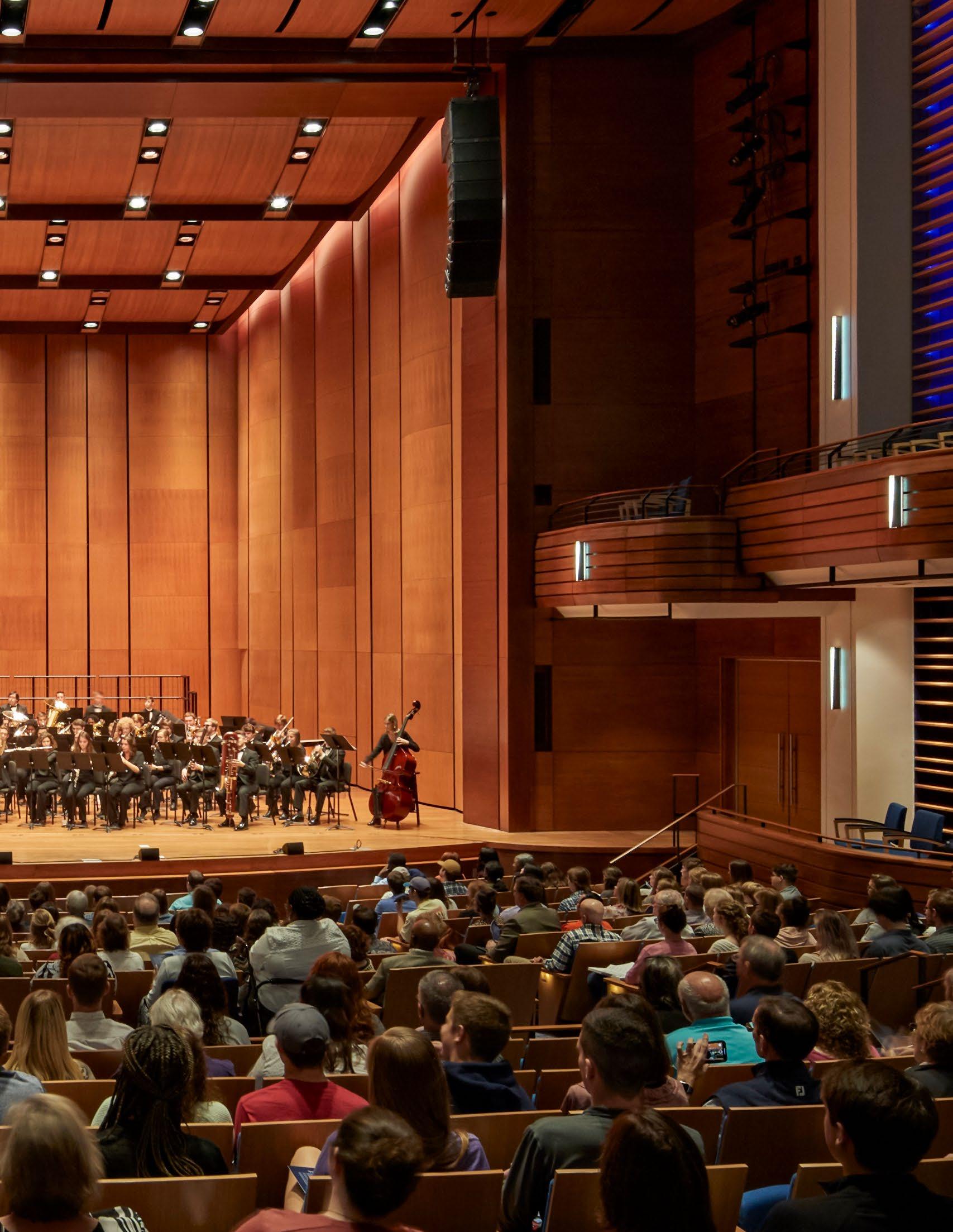
There are two ways that acoustics are controlled. The first, reverberation, is controlling how sound waves bounce off surfaces, like walls and floors. Hard surfaces cause more reverberation and make spaces louder. The second way, absorption, is the opposite of reverberation. Soft surfaces absorb sound waves and make rooms quieter.
Let’s see if we can figure out which of these materials cause reverberation and which cause absorption of sound:
• Tile
• Carpet
• Marble
• Curtains
• Cushions
• Wood
The controlling of reverberation and absorption of sound waves is how acoustics are controlled in the Woltosz Theatre.
Who to know at the show
COMPOSER SERGEI PROKOFIEV ALABAMA SYMPHONY ORCHESTRA

Born in late April 1891, Sergei Prokofiev began studying the piano with his mother at the age of 3. His significant musical skills were apparent very early in his life. He began composing as a child and had completed his first opera by the time he was 9. At age 13, he entered the St. Petersburg Conservatory, where he studied with the famous Russian composer Nikolai Rimsky-Korsakov. Prokofiev’s compositions used new-sounding harmonies and lively rhythms and often employed a sense of humor.
When the Russian Revolution began in 1917, Prokofiev fled to America. American audiences did not appreciate his work, so he moved to Paris. Parisians enjoyed his ballets and operas. In 1932, Prokofiev returned to his homeland, where he remained until his death on March 5, 1953. In the last 19 years of his life, he created some of his most well-known and beloved classical orchestral works, including Peter and the Wolf and the ballet Romeo and Juliet
The formation of the Alabama Symphony Orchestra (ASO) began with the first performance by a group of volunteer musicians in 1921. That group would evolve from a volunteer ensemble to the state's only full-time professional orchestra. Today, the ASO is continuing to make music and provide vital services to the residents of the state, serving nearly 100,000 individuals a year through concert series, youth programs and educational and community engagement efforts to fulfill their mission to change lives through music.
The ASO proudly works to produce creative, dynamic programming and to be recognized as an artistically innovative leader in the field—winning ASCAP Awards in 2010 and 2011 for Adventurous Programming and Dedication to New American Music and receiving an invitation to perform at Carnegie Hall in May 2012 as a part of the competitive Spring For Music Festival, which is underwritten by a $1 million grant from the Mellon Foundation.
The ASO has entertained and enriched audiences for more than 100 years, playing a variety of classical and popular music and hosting performances by some of the finest guest artists in the world. The 53 talented musicians of the ASO bring to life some of the world’s most treasured musical masterpieces and introduce listeners to exciting new works and composers, performing 100 concerts annually.
Sergei Prokofiev (April 27, 1891–March 5, 1953)
CONDUCTOR MARK ALPÍZAR
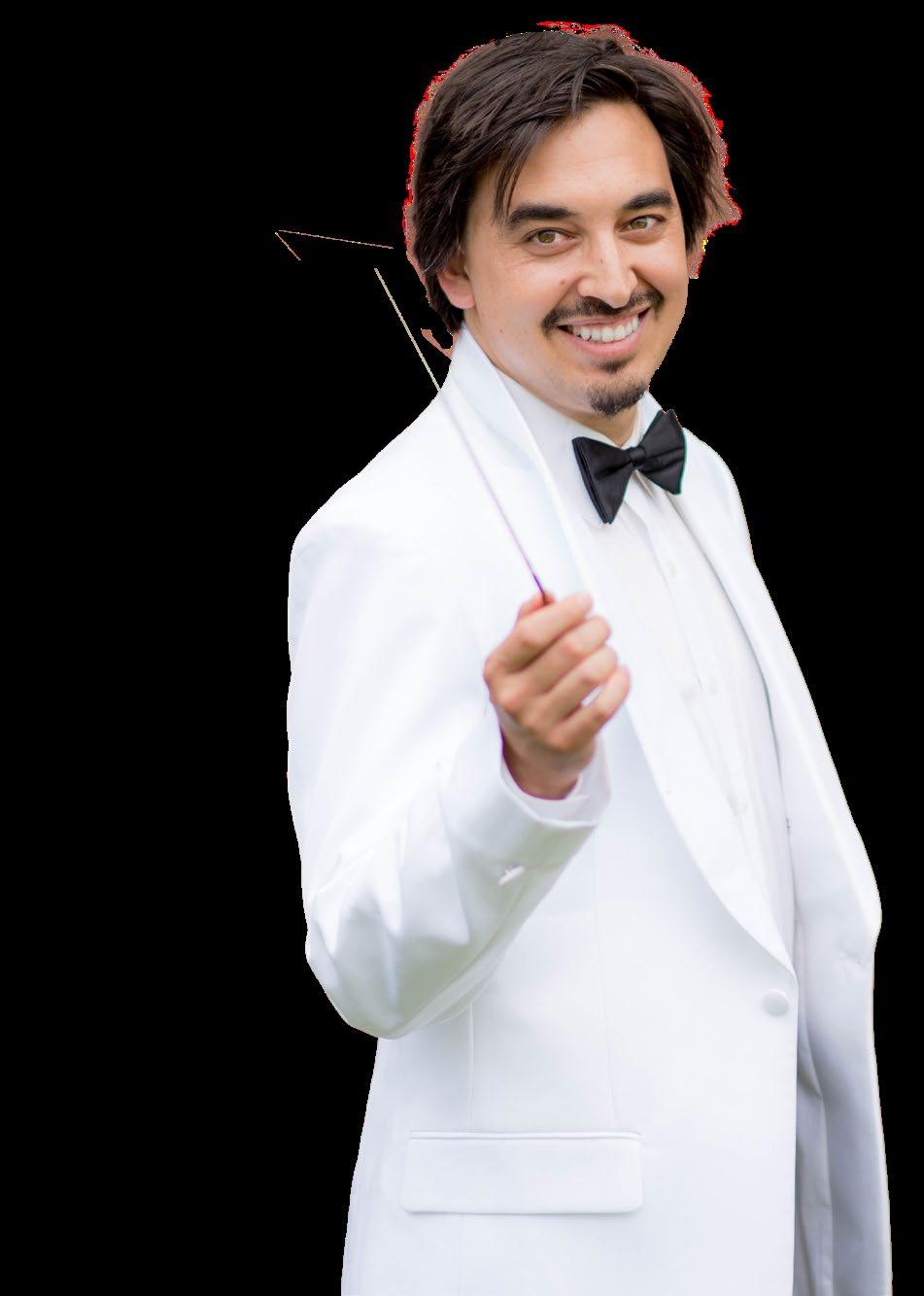
Southern California native Mark Alpízar has enjoyed a multifaceted career as a conductor, clarinetist and music educator throughout the United States. He is the music director of the Vermont Youth Orchestra Association and is currently a regular guest conductor of the Holland Symphony in Michigan, the conductor for Mariachi Garibaldi de Jaime Cuéllar, and the cover conductor of the Alabama Symphony. Prior to his move to Vermont, he was the assistant conductor of the Cleveland Pops Orchestra, Cleveland Pops Youth, the American Youth Symphony, the National Repertory Orchestra, and the Long Beach Symphony Orchestra. He holds a doctorate in orchestra and opera conducting from Arizona State University as well as bachelor's and master's degrees from the Cole Conservatory of Music.
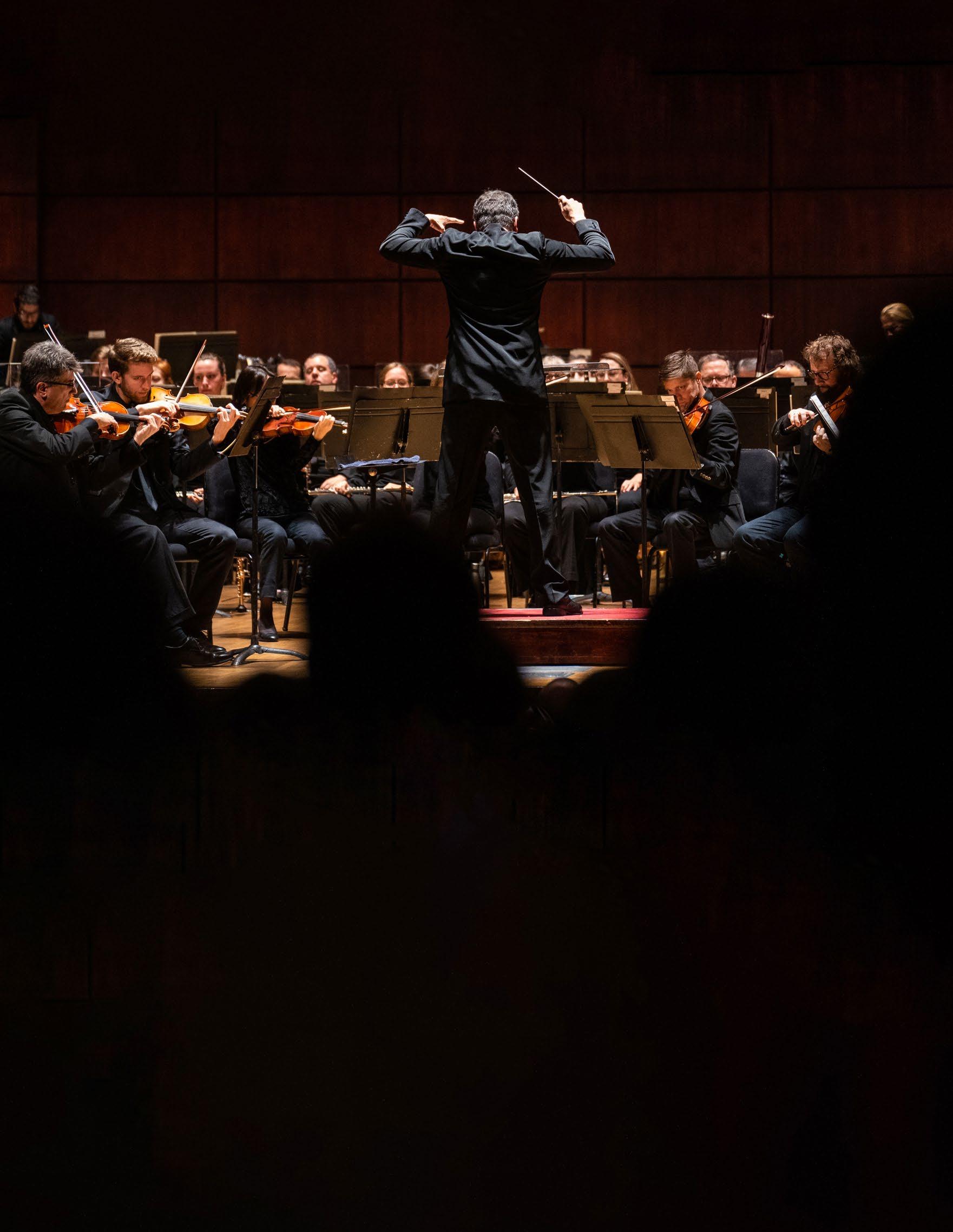 Alabama Symphony Orchestra
Alabama Symphony Orchestra
What to know before the show
ORCHESTRAL INSTRUMENTS & THEIR FAMILIES
In Peter and the Wolf, Prokofiev uses different orchestral instruments to represent each character in the story. Each of these instruments belongs to one of the four instrument families: string, woodwind, brass, and percussion.
String instruments are typically made of wood with strings made of nylon or steel. They are most often played with a bow or by plucking or strumming. A bow has a wooden handle and strings made from horsehair. The bow is pulled and pushed across the strings causing them to vibrate and create sound.
The violin is the smallest of the orchestral string instruments, and it plays the higher notes. The double bass is the largest of the orchestral string instruments, and it plays the lower notes. The viola is slightly larger than the violin and the cello is slightly smaller than the double bass.
Examples of string instruments include:
• autoharp
• bass
• cello
• double bass
• dulcimer
• electric bass
• fiddle
• harp
• harpsichord
• hurdy-gurdy
• lute
• lyre
• mandolin
• piano
• sitar
• ukulele
• viola
Woodwind instruments were originally all made of wood. This is not necessarily the case today, as woodwind instruments can be made of many different materials. They are cylindrically shaped instruments with keys and mouthpieces. Most woodwind instruments are played with reeds, though some are played by blowing air over a hole in the mouthpiece. The clarinet and saxophone are single reed instruments while the oboe and bassoon are double reed instruments.
Examples of woodwind instruments include:
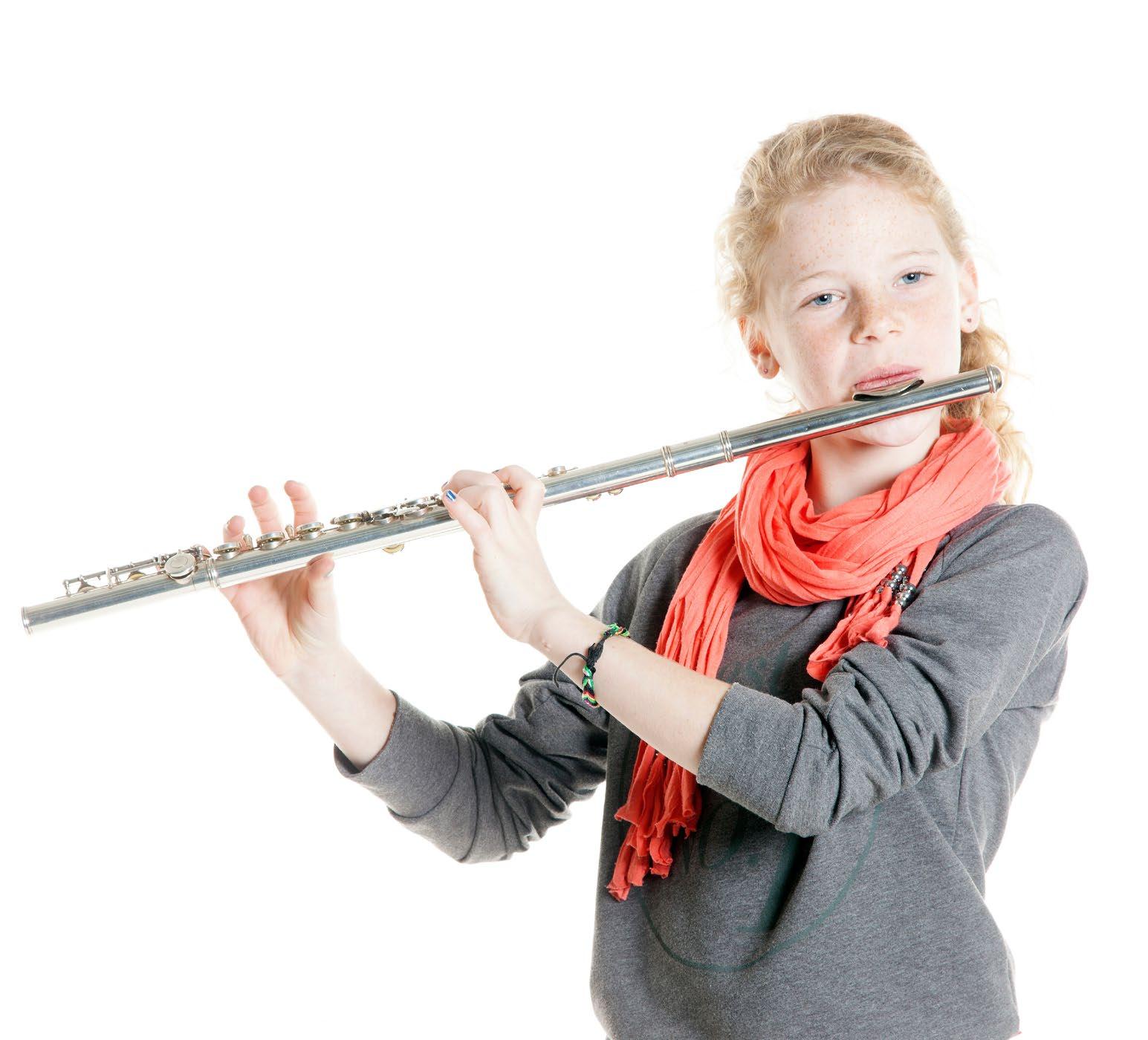
• bagpipes
• bassoon
• clarinet
• flute
• harmonica
• oboe
• piccolo
• recorder
• saxophone
12
Brass instruments were originally all made of brass. Today, they may be made of other metals. Brass instruments are all played by buzzing the lips against a mouthpiece. The sound comes out through a bellshaped end. The brass family is divided into two groups: valved and slide.
Examples of brass instruments include:
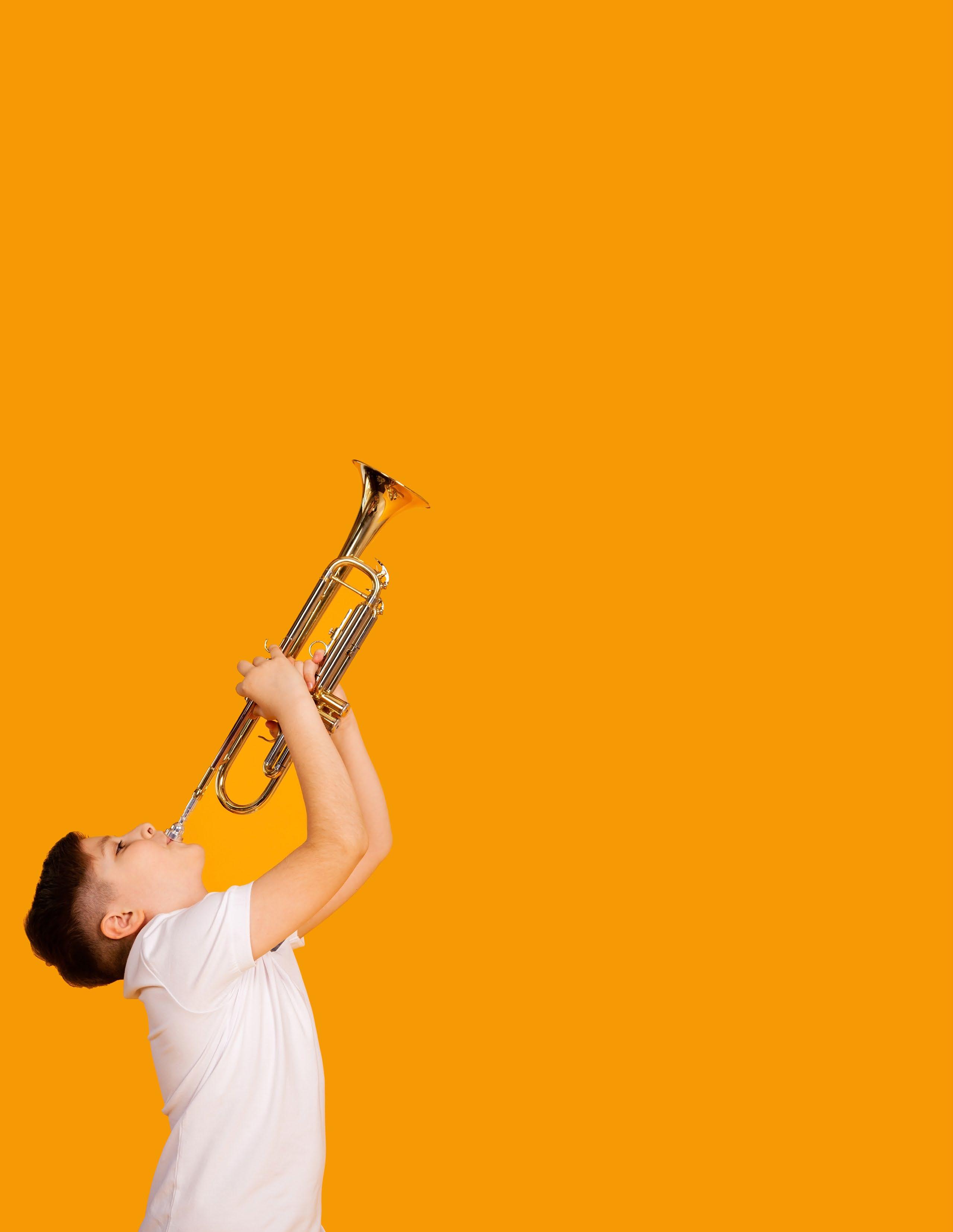
• bugle
• cornet
• euphonium
• French horn
• sousaphone
• trombone
• trumpet
• tuba
Percussion is the most varied of the instrument families. Though percussion instruments are various sizes and shapes and are made of a variety of materials, they all produce sound by being struck or hit. Members of the percussion family include all manner of drums. The percussion family can be divided between tuned and untuned instruments.
Examples of percussion instruments include:
• bass drum
• bells
• bongo
• blocks
• castanets
• chimes
• claves
• conga
• cowbell
• cymbals
• glockenspiel
• handbells
• maraca
• marimba
• snare
• tambourine
• timpani
• triangle
• vibraphone
• xylophone
Making Music of Your Own
Did you know the percussion family is the oldest musical instrument family? Believe it or not, many parts of our bodies can be used as percussion instruments. When you clap your hands or stomp your feet to form a rhythm, you are making music.
INSTRUMENTS IN PETER AND THE WOLF
The characters in Peter and the Wolf include a bird, a duck, a cat, Grandfather, hunters, the wolf and Peter. Each character is represented by a different instrument playing a specific musical theme.
Bird (flute)
The bird is represented by the flute. Every time you hear the flute play this theme, you know that the bird is there. Look at the music while you listen to the theme. Can you follow along? Do you think it sounds like a bird?
The flute is one of the earliest types of musical instruments. A member of the woodwind family, a flute produces sound when the flute player blows air across an opening in the mouthpiece. The flute player, or flautist, then presses down different combinations of keys along the body of the instrument to create the different notes.

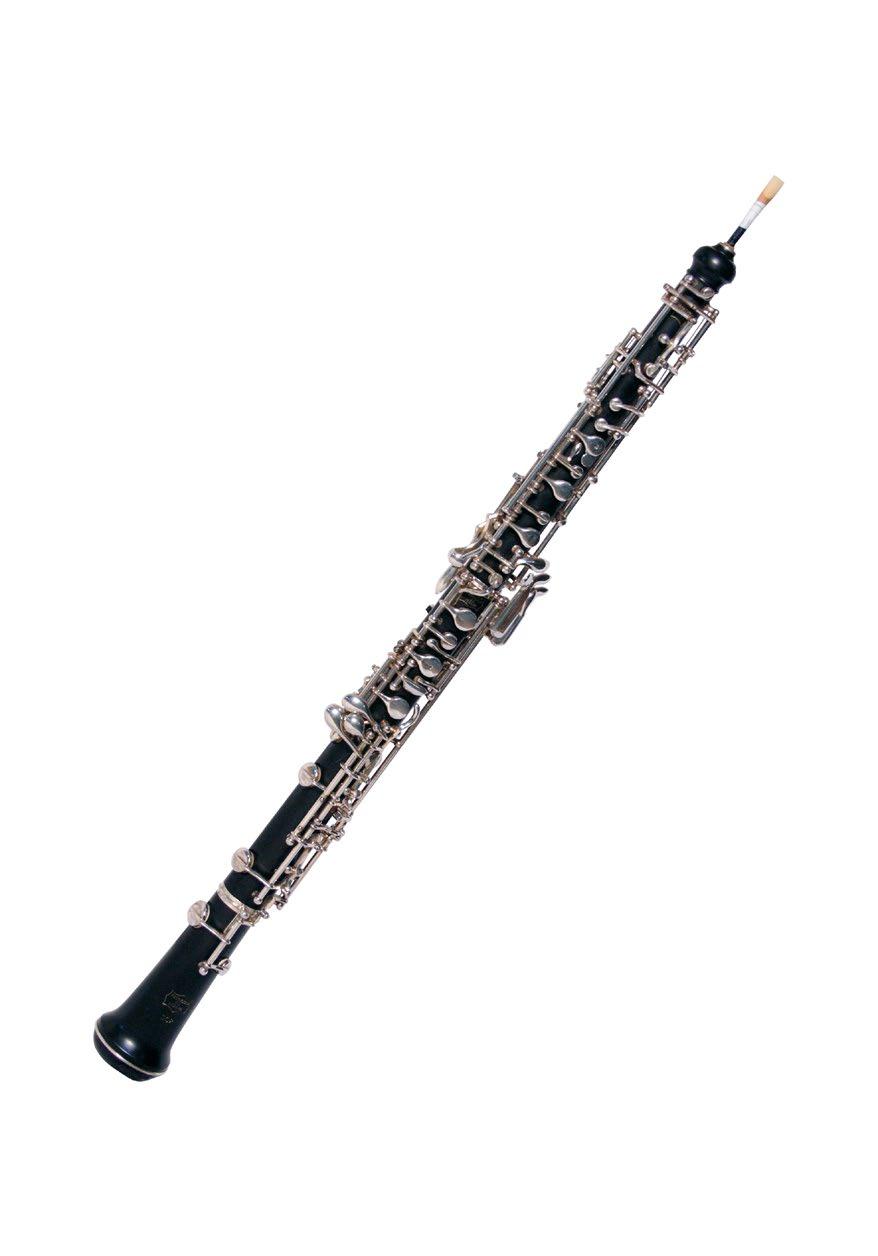
Duck (oboe)
The duck is represented by the oboe. Does the sound remind you of a duck?
The oboe is a conical-shaped instrument made of wood. It has a small bell at the end. The mouthpiece is a double reed and the oboist blows into the reed to make it vibrate. The reed is made of cane. Different keys are pressed to create the different pitches.
let’s listen
Click here to hear the duck's theme, played by the oboe.
let’s listen
Click here to hear the bird's theme, played by the flute.
14
Most woodwind instruments are played with a reed, a thin piece of wood that vibrates very quickly to produce sound in a musical instrument when the player blows air across it.
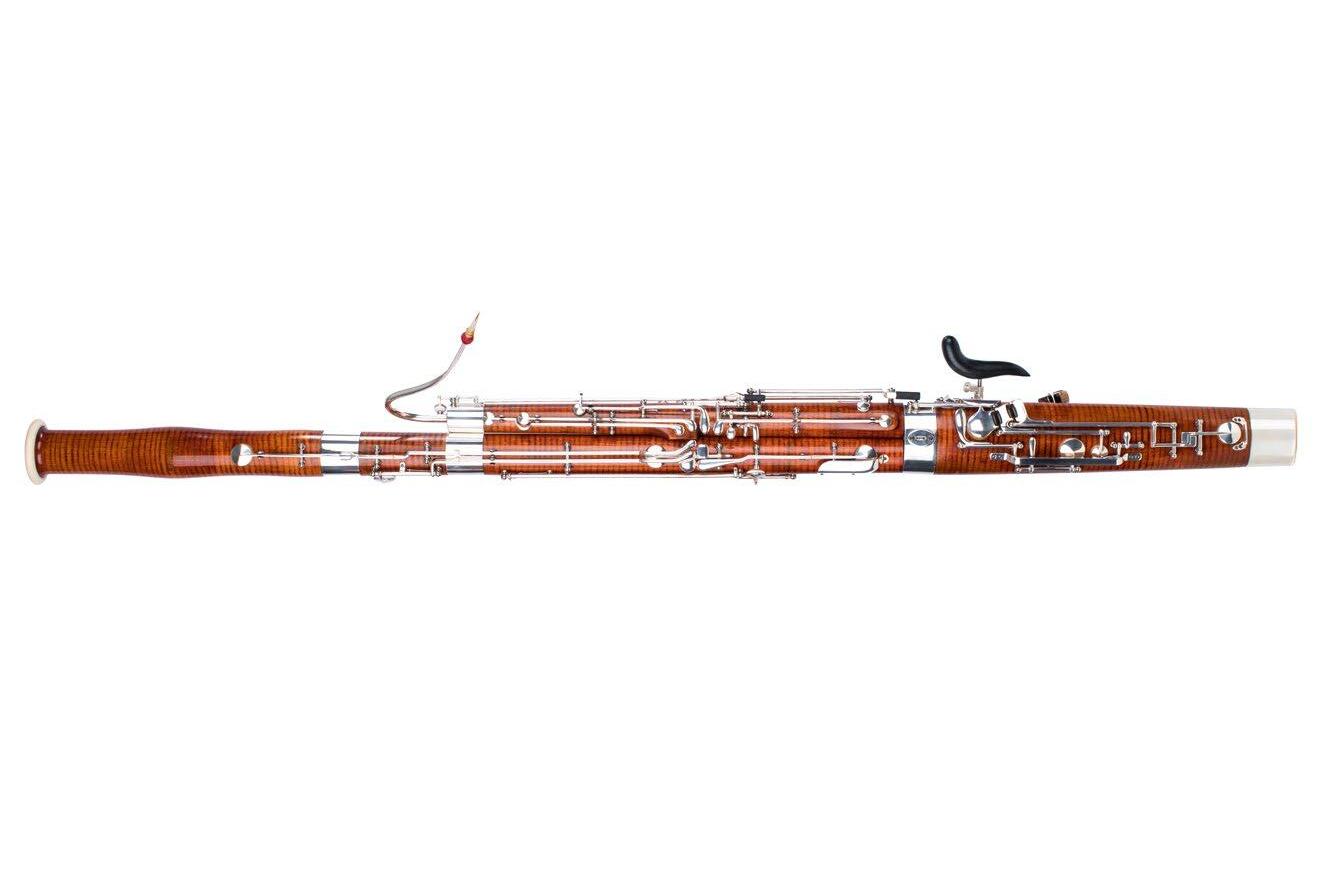
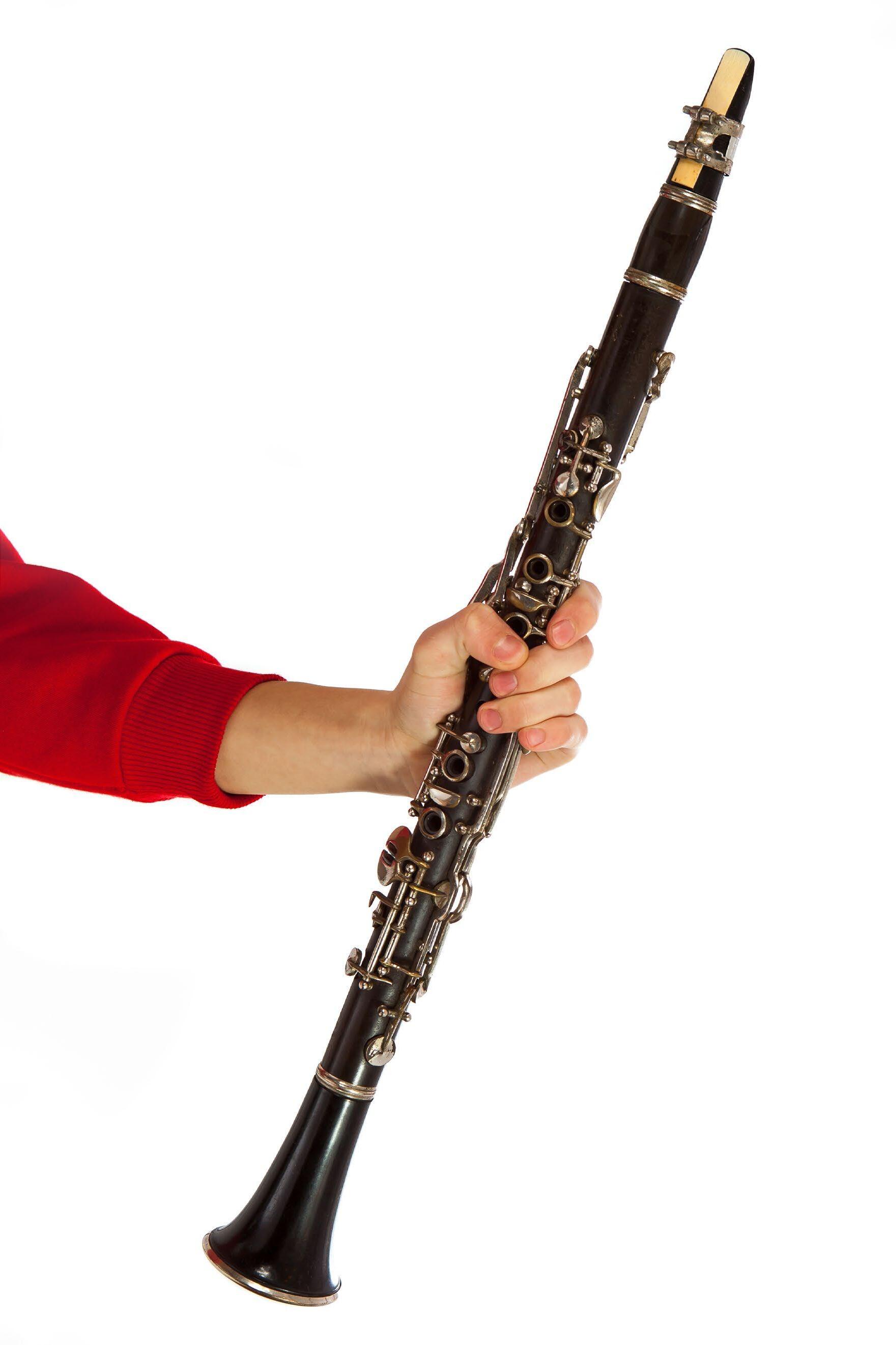
Cat (clarinet)
The cat is represented by the clarinet. The clarinet is another woodwind instrument with a cylindrical shape. The space inside the clarinet is the same diameter from top to bottom. It has a flared bell and keys along its side that are pressed to change the pitch. The clarinet mouthpiece has a single reed attached by a metal ligature.
let’s listen
is attached to a metal crook that comes from the instrument. The instrument is long and cylindrically shaped with keys similar to the other woodwind instruments. It has an opening at the top rather than the bottom.
let’s listen
Click here to hear the grandfather's theme, played by the flute.
15
Wolf (French horns)
Three French horns represent the wolf. The French horn is a brass instrument. It is made up of metal tubing that is rather narrow by the mouthpiece and widens as it twists and turns its way to the bell. The bells on brass instruments are much larger than those on the woodwind instruments. The mouthpiece of the French horn is cup-shaped with a rim where the player places their lips. To play the French horn, the player buzzes their lips into the mouthpiece. Pitch can be changed by changing their embouchure, or mouth position, and by pressing combinations of the three valves. Pressing the valves allow the air to travel through additional tubing of the instrument.

let’s listen
Click here to hear the wolf's theme, played by the French horns.
Hunters (timpani)
The hunters' theme is represented mostly by woodwind instruments, while the timpani is used to represent their gunshots. The timpani are percussion instruments that are sometimes called kettle drums because of their kettle shape. They are most commonly made from copper with a plastic head stretched over the top opening. Timpani come in different sizes and are usually played in sets of three, four or five. They each have a pedal that allows the drumhead to be loosened or tightened to change the pitch. Timpani fall in the pitched percussion category and though played with mallets striking the heads, they play specific notes and not just rhythms.
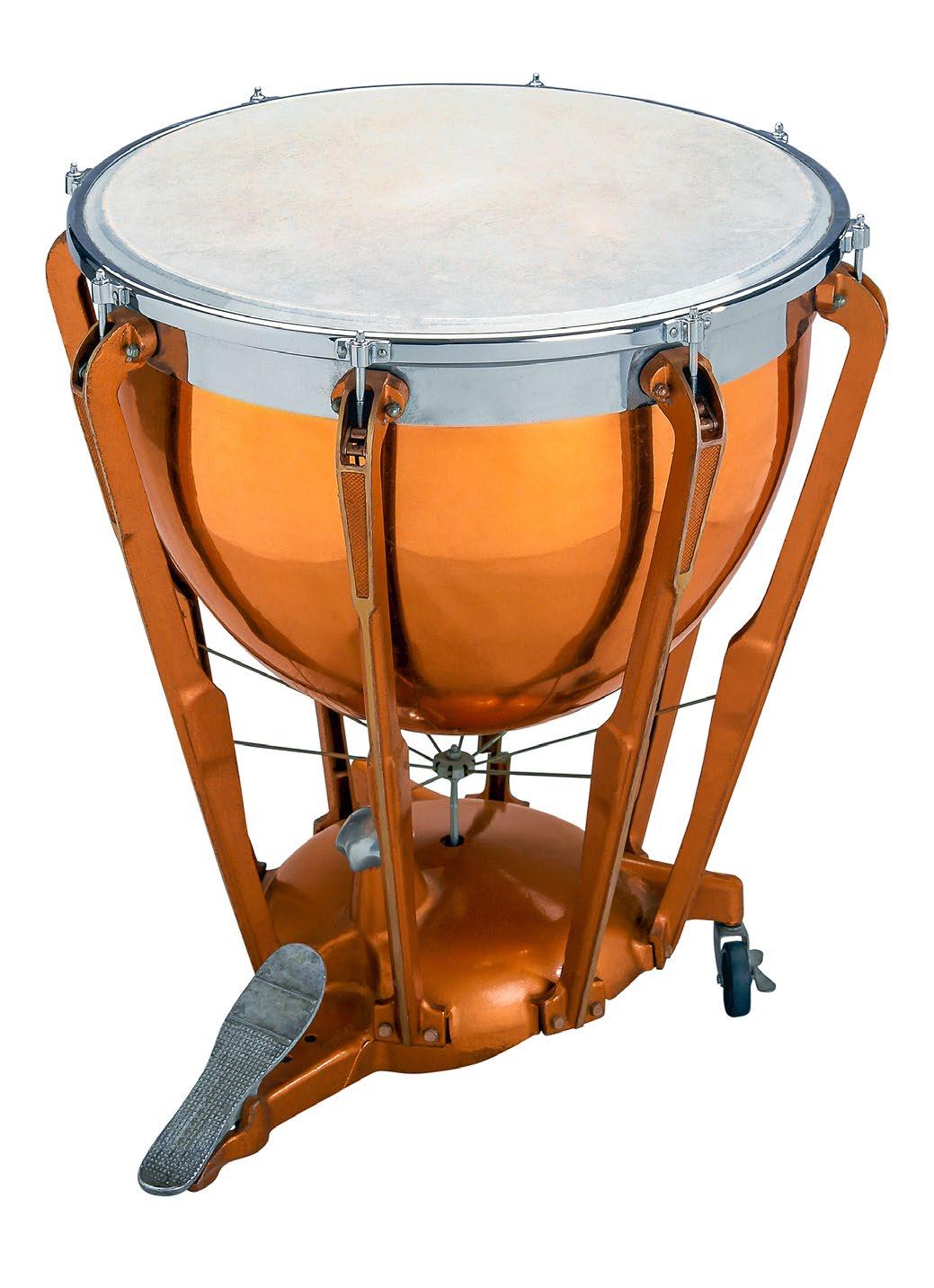
let’s listen
Click here to hear the hunters' theme, played by the timpani.
16
Peter (strings)
Peter is represented by the string instruments of the orchestra. The string family is the largest section of the orchestra and they sit in the front. All of them are made of wood and have four strings that are usually played with a bow but can also be plucked. The smaller two, the violin and viola, are held under the chin while the larger two rest on the floor and are balanced by the players body. The cello rests between the cellist knees and sits on the floor in front of them, while the bassist must stand or sit on a high stool to play.

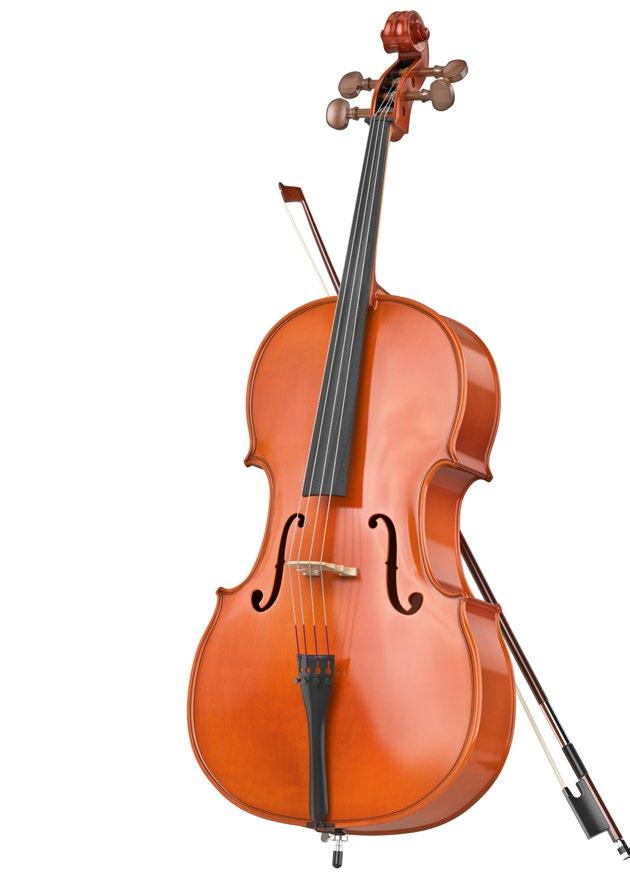
let’s listen
Click here to hear Peter's theme, played by orchestra's string section.


Listen Up
Now that you know the characters, their themes and the instrument that play them in Peter and the Wolf, listen carefully during the performance to see if you can hear them.
17
FAIRY TALES
What is a fairy tale? A fairy tale is a short story that might include magic or mythical creatures and belongs to the folklore genre. Folklore includes the stories, traditions, beliefs and even objects of a particular culture. In fact, sometimes fairy tales are called folk tales. Though fairy tales typically include characters like fairies, witches, wizards and monsters, they also include talking animals, as is the case in Peter and the Wolf. Can you think of some other fairy tales you have heard? Maybe the story of Cinderella, or Pinocchio? What about Hansel and Gretel or Goldilocks and the Three Bears?
Fairy tales all share several elements. Though many may begin, “once upon a time” and end “happily ever after,” those phrases are not a requirement for a fairy tale. However, they usually will have a distinct beginning and ending, and are often set in the past, but not a specific period of history. Frequently, they have happy endings. Additionally, fairy tales usually employ some elements of magic, which can involve characters with magical powers, magical spells or talking animals. The purpose of the fairy tale comes down to the problem that needs to be solved. The problem can be a physical challenge that only the hero can accomplish, or it may be a circumstance that must be overcome. The problem, or conflict, is the core of the fairy tale. The characters of a fairy tale include three specific types: a hero, a villain and a helper, and they are most often found living in a forest or a castle.
In the story of Cinderella, which character is the hero? The villain? What about the helper? Is there more than one? We could say that Cinderella is the hero, the stepmother is the villain, and the Fairy Godmother is the helper. What is the problem that needs to be solved? Well, it’s getting Cinderella to the ball after her dress is ripped and ruined by her evil stepsisters. What is the element of magic?
Bibbidi, Bobbidi, Boo!
Elements of a Fairy Tale
Distinct beginning and end
• "Once upon a time ..."
• "... happily ever after."
Set in the past
Elements of magic
• Magical powers
• Spells
• Talking animals
A hero, a villain and a helper
A problem or conflict that must be solved
A happy ending
18
CAUSE & EFFECT: CHARACTER EDUCATION
Cause and effect link two things together with one being the result of the other. It is the "why" and the "what." The cause is why something happened while the effect is what happened. It is the action and the reaction. Cause and effect happen in all areas of human experience. Cause and effect can be found in science. For example, leaving a piece of ice on a table will cause it to melt. Cause and effect can be found in mathematics and also be part of a story, creating character-building or lesson-learning opportunities.
There are some keywords that can help identify cause and effect: because, if, so, then, since, before and after.
If you leave a piece of ice on a table, then it will melt.

The cause is leaving the ice on the table, and the effect is the ice melting.
Sometimes cause and effect can also be an action and its consequence. If you choose to disobey, then there will be consequences. In Peter and the Wolf, Peter chooses to disobey Grandfather by leaving the yard again to try to capture the wolf. Though Peter captures the wolf, Grandfather is disappointed in him because he was disobedient. Grandfather’s disappointment is the effect of Peter’s disobedience (the cause). The choices you make can affect others. Your actions (the cause) can affect how other’s feel (the effect). When we make decisions, it is good to think about all the effects those decisions can have. Be kind and fair. Show respect for others. Be honest. Use self-control. Be cooperative and compassionate. What other qualities did Peter have?
Cause & Effect
The linking of two actions, the second action being the result of the first
An action (something you do) and its consequences (something that happens as a result of the action)
Keywords may include:
• Because
• If
• So
• Then
• Since
• Before
• After
19
MUSICAL INSTRUMENT FAMILIES
Alabama Course of Study Standards
OBJECTIVE
By completing this activity, students will learn how to:
• Identify the orchestral instrument families
• Name specific instruments belonging to each orchestral instrument family
• Recognize the sound of the instruments from Peter and the Wolf
• Listen to, analyze and describe the musical excerpts
MATERIALS
For this activity, you will need the following items:
• "Orchestral Instruments & Their Families" lesson on page 12.
• A device with internet access to play videos/musical clips
• Board or poster paper and writing utensils
• Paper and writing utensils
PROCEDURE
To complete this activity, follow these steps: Introduce the four orchestral instrument families using the "Orchestral Instruments & Their Families" lesson on page 12.
1. As a class, watch the video linked below.
X Musical Instruments: Names and Sounds for Kids to Learn
2. As you are watching the video, be sure to point out the different instrument families represented and make note of the instruments featured in Peter and the Wolf.
note: With the exception of the timpani, all of the character instruments featured in Peter and the Wolf can be seen/heard in this video.
3. Listen to this excerpt from Benjamin Britten’s Young Person’s Guide to the Orchestra and have students indicate when they hear the different instrument families.
4. Listen again and ask students if they can recognize the different individual instruments within each family.
5. On the board, create an instrument families chart similar to the graphic on the following page (right).
6. Now listen to this excerpt from Shostakovich’s Symphony No. 12. As they listen, have students write down one instrument they hear on a sheet of paper.
7. Have students place their papers under the instrument family to which they believe their chosen instrument belongs. Discuss their findings.
8. In Peter and the Wolf, Prokofiev uses instruments from the different instrument families to represent the various characters within the story. Listen to each character's theme linked below. If appropriate, show the music so the students can follow along.
X The flute represents the bird.
X The oboe represents the duck.
X The clarinet represents the cat.
X The bassoon represents Grandfather.
X The French horns represent the wolf.
X The timpani represent the hunters.
X The strings represent Peter.
9. Discuss the instrument choices made by Prokofiev for each character.
suggested discussion questions
• Why might the composer have chosen the flute to represent the bird?
• What about the oboe for the duck, or the bassoon for Grandfather?
• How about the French horns for the wolf?
• Why all the strings for Peter?
hint: There are no wrong answers, but help students think about things like the timbre of the instruments, high and low qualities of instrument sounds, the size of instruments, how the instruments are played, the dynamics of instruments (loud/soft).
20
AE17.MU.1.17 AE17.MU.2.17 AE17.MU.3.17 AE17.MU.3.19
Re8.1.K-3
National Standards
Brass Percussion String Woodwind
French horn
10. On the board, write the names of four of five different animals that are not featured in Peter and the Wolf (e.g., elephant, lion, ant, dog, giraffe, horse, cow, etc.).
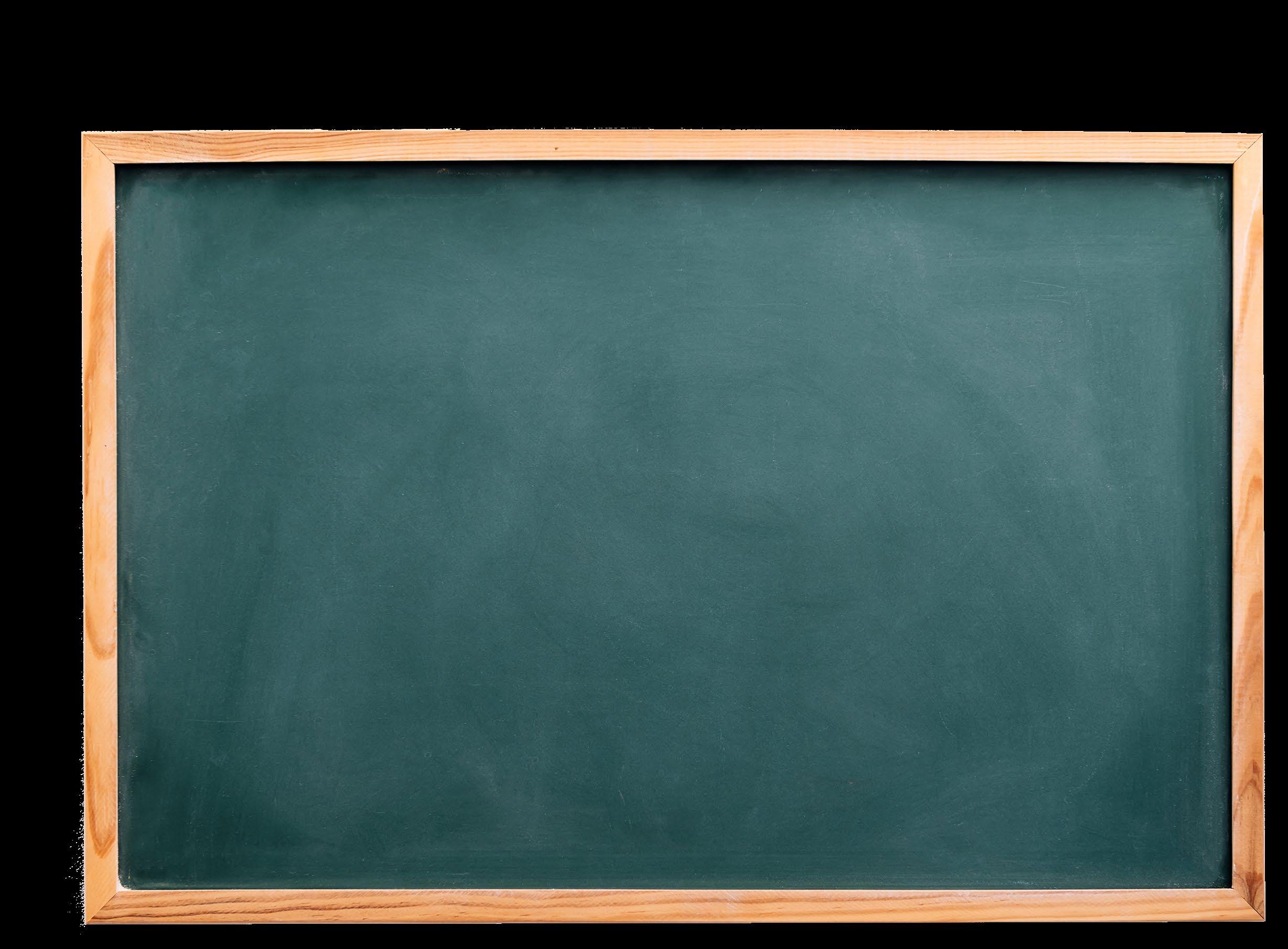
activity option one
Create a list of instruments and have the class discuss and choose which instruments best represent the animals on the board.
activity option two
Have students create a list of instruments on their own. As a class, discuss and choose which instruments best represent the animals on the board.
activity option three
Have students create a list of instruments on their own. Have students choose an animal and write about which instrument they would choose to represent it and why.
11. Complete the activity by reviewing the four instrument families and have students identify the family for each of the instruments listed or chosen.
additional / alternate activity
matching game
Using the "Whose Sound is That?" worksheet and supplemental materials on the following pages, have students cut out the Peter and the Wolf character and instrument cards. With appropriate guidance, have them paste the correct character and instrument card pairings onto the worksheet.
bonus: Have students place the correctly paired character and instrument cards in the order in which they appear in Peter and the Wolf.
21
Violin
Trumpet
Oboe
Clarinet
Bassoon
Flute
Trombone
Timpani
Cymbal
Whose Sound is That?
Using your Peter and the Wolf character and instrument cards, pair each character with its correct instrument in the spaces below.
Name
Date Character Character Character Character Character Character Character Instrument Instrument Instrument Instrument Instrument Instrument Instrument
Following the dotted lines below, carefully cut out the Peter and the Wolf character and instrument cards.
Bird Bassoon
Cat Clarinet
Duck Flute
Grandfather
French horn
The Hunters Oboe
Peter Strings
Wolf Timpani
OBJECTIVE
By completing this activity, students will learn how to:
• Create two-dimensional art
• Use art vocabulary while creating art
MATERIALS
For this activity, you will need the following items:
• Black crayons
• Watercolor paint
• White paper
• Visual of Kandinsky's Blue Crest painting (right)
QUESTIONS
Using the visual of Kandinksy's Blue Crest, painting (right), ask students the following questions:
• What different types of lines can you name? Pretend to draw different types of lines in the air.
• What types of lines do you see in this painting? Point out the different types of lines in the painting.
• What shapes and colors do you see in this painting?
• Do you see lines and colors repeated in this painting?
• How does your eye travel around the painting? What do you notice first?
• What type of music do you think you would hear in this painting?
PROCEDURE
To complete this activity, follow these steps:
1. Demonstrate how to draw different types of lines with the black crayon on your paper.
2. After students complete their lines, discuss how Kandinsky repeated color in his art to make the works more unified.
3. Have students use watercolor paint to fill the spaces between the lines.
4. Have them use the same color four times in different places on their art to help it be balanced and unified.
Who Was Wassily Kandinsky?
Wassily Kandinsky was a Russian painter and abstract art pioneer. Abstract art is art that does not look like something seen in real life. Although many artists of his time were moving away from realistic painting, Kandinsky was one of the first whose work explored the use of brilliant colors, varied lines and geometric shapes. During Kandinsky's lifetime, many in the art world did not appreciate his work. Today, however, his paintings are recognized as the beginnings of modern art.
Kandinsky was a contemporary of Peter and the Wolf composer Sergei Prokofiev, and he was intrigued with the power of music. He believed that music had the unique ability to reach people on an emotional level because it could not be seen, only experienced in the moment. He also believed that creating a painting was like writing music—it was a way to tell a story or idea. Instead of objects, Kandinsky’s paintings feature abstract forms and bold colors. At first glance, they may look simple, but if you look carefully, you can see how his art reflects music and sounds.
Wassily Kandinsky (July 14, 1912–October 3, 1967)

24 MUSIC & ABSTRACT
ART
Alabama Course of Study AE17.VA.K.1 AE17.VA.K.1a AE17.VA.K.3 AE17.VA.K.6a AE17.VA.1.2 AE17.VA.1.2a AE17.VA.1.3 AE17.VA.1.6 AE17.VA.1.6b AE17.VA.2.2a AE17.VA.2.3 AE17.VA.2.6 AE17.VA.2.12 AE17.VA.2.13 AE17.VA.3.1 AE17.VA.3.3 AE17.VA.3.10 AE17.VA.3.13 National Standards Cr1.1.K-3

25
Wassily Kandinsky, Blue Crest, 1917, oil on canvas, 52.4 x 40.9 inches (46.5 x 67.5 cm), The Russian Museum, St. Petersburg.
OBJECTIVE
By completing this activity, students will learn how to:
• Identify the main elements in a literary text
MATERIALS
For this activity, you will need the following items:
• Story map handout
• Story
• A device with internet access to read select stories
• Board and writing utensil
PROCEDURE
To complete this activity, follow these steps:
X Read the Three Little Pigs.
1. As you read, pose story-dependent questions and allow students to answer.
suggested questions
• Who are the characters?
• What is the setting?
• What happens to the first pig's house?
• "Furze" is an unfamiliar word to me. How can I use what I already know about this story to figure out what "furze" means?
• What happens when the wolf cannot blow the brick house down?
• How does the third pig outsmart the wolf each time?
• What happens to the wolf when he tries to go down the chimney?
2. Introduce and review the elements of the story. story elements to introduce
• Characters
• Setting
• Plot (beginning, middle, end)
• Conflict
• Point of view
3. Using the story map graphic below, create a story map on the board. As a class, fill in the details from the story.
4. Choose another story to read as a class or allow students to read on their own.
suggested stories
X Sleeping Beauty
X Goldilocks and the Three Bears
X Little Red Riding Hood
X Cinderella
5. Distribute the "What Happened" worksheet (right) and ask students to complete the map as they read. Use multiple worksheets if reading multiple stories.
6. Allow students to talk in groups or pairs and use their completed story maps to retell the fairy tale in their own words
7. Move around the room and listen to the retellings, making sure that the students are correctly identifying the main elements of the story.
26 FAIRY TALES & FOLKTALES
Standards ELA21.K-1.2 ELA21.K.27 ELA21.1.23 ELA21.2.23 ELA21.2.30 ELA21.3.18 ELA21.3.19 ELA21.3.20 ELA21.3.22 ELA21.3.29 National Standards NL-ENG.K-12.1 NL-ENG.K-12.2 NL-ENG.K-12.3 Characters Setting Beginning Middle End story map reference
Alabama Course of Study
Characters
What Happened?
Fill in the boxes below to create a story map.
Who is in the story? What are their names?
Setting
Where and when does the story take place?
Conflict
What problems or obstacles do the characters in the story have to overcome?
Plot
What do the characters do in the story? What events or actions occur?
Resolution / Ending
How do the characters solve the conflict? How does the story end?
Name
Date
CAUSE & EFFECT
OBJECTIVE
By completing this activity, students will learn how to:
• Create a connection between cause/action and effect/consequence
• Identify emotions
• Draw connections from their own experiences
MATERIALS
For this activity, you will need the following items:
• Peter and the Wolf story
• "Cause & Effect" lesson on page 19.
• "Mood Journal" and "Actions & Consequences" worksheets
• Writing utensils
PROCEDURE
To complete this activity, follow these steps:
1. Read Peter and the Wolf on page 30.
2. Discuss the choices Peter makes throughout the story and the effects or consequences his actions have on others. Which character traits does Peter exhibit (or not exhibit) when making these choices?
suggested actions / consequences to discuss
• When Peter goes to the meadow, he does not close the gate. By leaving the gate open, the duck is able to enter the meadow and is eaten by the wolf.
• Peter goes home when he is told. Grandfather is proud of his obedience and believes Peter is safe.
• Peter sneaks back out of the yard despite what Grandfather told him. Thought Peter is able to save the cat and bird, he disappoints Grandfather.
• Peter works with the bird. By cooperating together, Peter and the bird are able to capture the wolf.
• Capturing the wolf
3. Review the "Cause & Effect" lesson on page 19.
4. Have students complete the "Mood Journal" and "Actions & Consequences" worksheets.
5. Worksheets can be completed by students individually or together as a class.
28
Alabama Course of Study Standards CE.K-12.1 CE.K-12.4 CE.K-12.6 CE.K-12.7 CE.K-12.8

29
PETER AND THE WOLF
Early one morning, Peter opened the gate and went out into the big green meadow.
On a branch of a big tree sat a little bird, Peter’s friend. “All is quiet,” chirped the bird gaily.
Just then a duck came waddling by. She was glad that Peter had not closed the gate and decided to take a swim in the pond in the meadow.
Seeing the duck, the little bird flew down upon the grass, settled next to her and shrugged her shoulders.
"What kind of a bird are you, if you can't fly?" the little bird asked. "What kind of bird are you, if you can't swim?" the duck replied, then dived into the pond.
They argued and argued—the duck swimming in the pond, the little bird hopping along the shore.
Suddenly, something caught Peter's attention. He noticed a cat crawling through the grass.
"Look out!” shouted Peter. The bird immediately flew up into the tree.
Meanwhile, the duck quacked angrily at the cat.
The cat walked around the tree and thought, "Is it worth climbing up so high? By the time I get there, the bird will have flown away."
Grandfather came out. He was angry because Peter had gone into the meadow. "It is a dangerous place. If a wolf should come out, then what would you do?” Grandfather asked.
Peter paid no attention to his words. “Boys like me are not afraid of wolves,” he thought to himself. But Grandfather took Peter by the hand, locked the gate and led him home.
No sooner had Peter gone, than a big gray wolf came out of the forest.
In a twinkling, the cat climbed up the tree.
The duck quacked and, in her excitement, jumped out of the pond.
But no matter how hard the duck tried to run, she couldn’t escape the wolf.
He was getting nearer and nearer, catching up with her.
And then . . . he caught her! And, with one gulp, he swallowed her.
And now, this is how things stood: the cat sat on one branch.
The bird sat on another, but not too close to the cat.
And the wolf circled the tree, looking at the cat and the bird with greedy eyes.
30
In the meantime, Peter, without the slightest fear, stood behind the closed gate, watching all that was going on.
He ran home, got a strong rope and climbed the high stone wall. One of the branches of the tree stretched out over the wall.
Grabbing hold of the branch, Peter lightly climbed over on the tree.
Peter said to the bird, “Fly down and circle the wolf’s head. But take care he doesn’t catch you!”
The bird almost touched the wolf’s head with his wings while the wolf snapped angrily at him.
How the bird did worry the wolf, and how the wolf tried to catch him! But the bird was cleverer, and the wolf simply couldn’t do anything about it.
Meanwhile, Peter made a lasso, and by carefully lowering it, caught the wolf by the tail and pulled with all his might!
The wolf, feeling himself caught, began jumping wildly to get loose.
But Peter tied the other end of the rope to the tree, and the wolf’s jumping only made the rope pull tighter around his tail.
Just then, the hunters came out of the woods.
They were following the wolf’s trail and shooting as they went.
But Peter, sitting in the tree, said, “Don’t shoot! Bird and I have caught the wolf. Now help us take him to the zoo!”.
So! So!
Imagine the triumphant procession.
Peter is at the head.
After him, the hunters lead the wolf.
And winding up the procession are Grandfather and the cat. Grandfather tossed his head discontentedly and said, “Well! And what if Peter hadn’t caught the wolf? What then?”
Above them flew the bird, chirping merrily. “My! What brave fellows we are, Peter and I!” he said. “Look at what we have caught!”
And if one would listen very carefully, one could hear the duck quacking inside the wolf, because the wolf, in his hurry, had swallowed her—alive!
31
Mood Journal
Use the words in the word cloud to complete the sentences below. Try to use different words for each sentence.
When I see my best friend, I feel .
When I play my favorite game, I feel .
When I win a game, I feel .
When it is time to go to bed, I feel
When someone cuts in front of me in line, I feel
When I lose a toy, I feel
When I go to a new place, I feel .
Date
Name
Actions & Consequences
Use the words in the word cloud to complete the sentences below. Think about how the choices you make affect others (and yourself) when choosing your words.
If I choose to share my toys with a friend, they may feel . This makes me feel
If I let my classmate go in front of me in line, they may feel This makes me feel .
If I do not listen to my teacher, they may feel . This makes me feel .
If I show kindness to others, they may feel
This makes me feel
If I make fun of someone, they may feel . This makes me feel .
If I choose to use self-control, my teacher may feel .
This makes me feel
Name
Date

Red wolf Canis rufus
Why we go to the show
ALABAMA WILDLIFE
The story of Peter and the Wolf takes place in a meadow just outside the woods. There Peter encounters several animals including a bird, a duck, a cat, and, of course, a wolf.
The state of Alabama is filled with woods and meadows where you may encounter birds, ducks and cats. Have you ever seen any of these animals? Maybe you even have a pet cat or bird? Did you notice that wolves were not on that list of animals you may encounter in Alabama?
Wolves are the largest members of the canine family, the same family as dogs. Other members of the canine family include coyotes and jackals. The gray wolf is found in Europe, Asia and North America. The area where wolves are found today has been greatly reduced due to human interference.
The red wolf is a relative of the gray wolf and is native to the Southeast portion of the United States. Alabama was home to the red wolf up until the midtwentieth century. In the 1960s, the red wolf nearly became extinct due to aggressive population control programs aimed at protecting livestock. In 1980, the red wolf was declared extinct in the wild, though there was still a small population in captivity. That means there were no more red wolves living in the wild. The U.S. government worked to reintroduce the red wolf into the wild of North Carolina and, while populations did eventually rise to as many as 120 by 2012, there were only eight left by 2021. Through more concentrated efforts from the government and other conservation groups, the 2023 wild red wolf population has grown to 15–17, all found in the Alligator River National Wildlife Refuge in North Carolina. That means there are no longer wolves living in the wild here in the state of Alabama.
Alabama does, however, have a huge population of birds. Did you know that there are 433 bird species in Alabama, including some of the rarest bird species in the world? Alabama is one of the most biodiverse states in the whole country and this bird population is part of the reason why!
There are more than 10,400 bird species in the whole world. The first thing that distinguishes birds from other animals is their feathers. No other animals on earth have feathers. Birds also have beaks, not teeth, and lay eggs. Birds have wings, but not all birds fly. Birds are warm-blooded and have four-chambered hearts. They live all over the world from Antarctica to Africa, from America to Asia. Birds tend to be social animals and communicate vocally through songs, chirps and calls. Many types of birds travel in flocks, some birds migrate long distances for different seasons, while others stay in the same place their entire lives.
Birds come in many shapes and sizes and vary greatly in their coloring as well, from the pink flamingo to the black crow and everything in between. The coloring of birds is found in their feathers. Bird feathers are related to scales, like those found on reptiles. They help birds stay warm and they help them to fly. Often the male and female of the same type of bird have very different feather colors. That is because sometimes male birds use their feathers to attract mates.
Dinosaurs Among Us
Did you know birds are descended from dinosaurs? Modern birds evolved from theropods. While today's birds have certainly evolved from their theropod origins 230 million years ago, scientists consider birds to be living dinosaurs.
35
Birds of Alabama
Did you know that Alabama is nicknamed the Yellowhammer State, after the state bird?
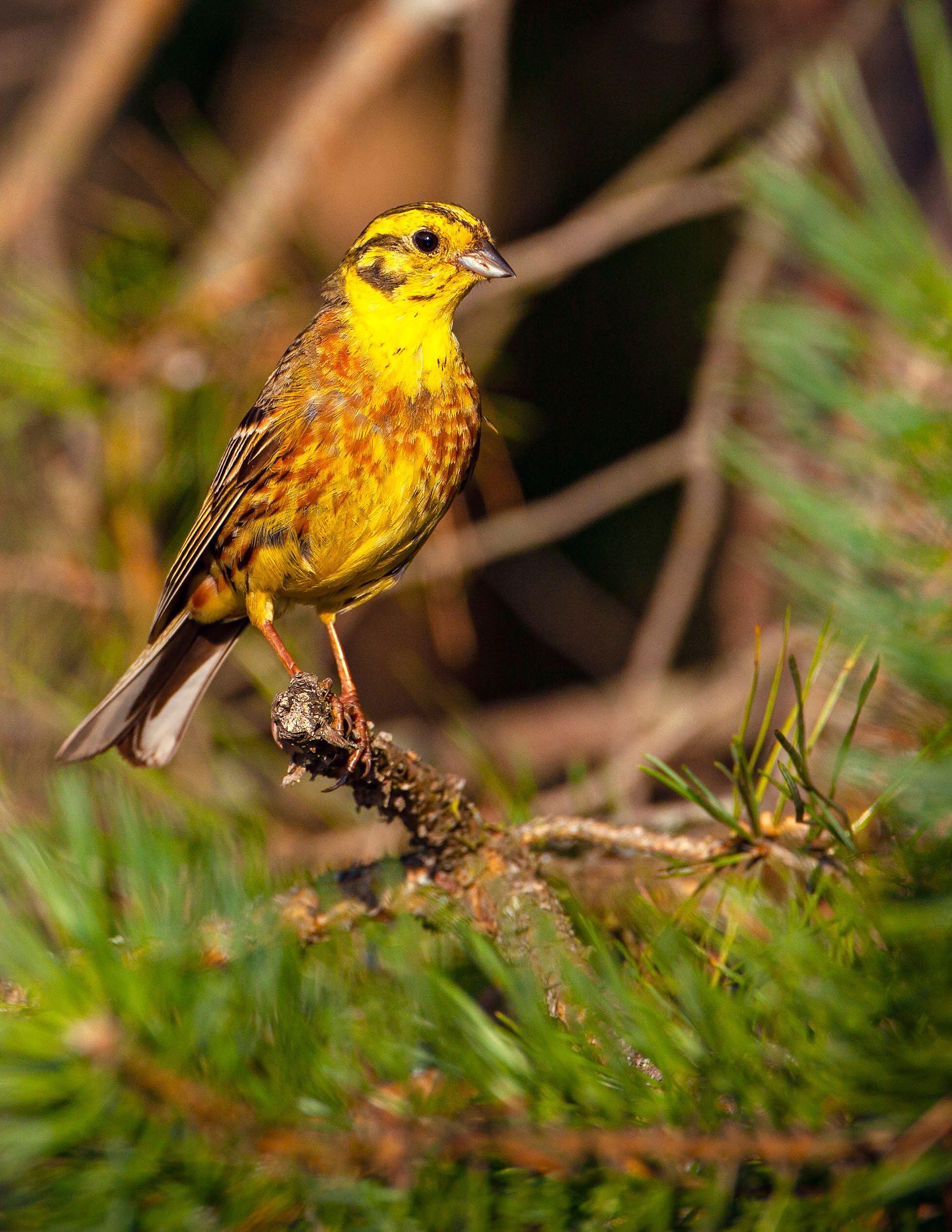
You can find many types of birds in Alabama, including waterfowl like ducks and geese; birds of prey like eagles, hawks, osprey, falcons and vultures; game birds like chickens, turkeys and quail; cranes; herons; hummingbirds; owls; perching birds like crows, swallows, jays, finches, sparrows, wrens and larks; pigeons and doves; shorebirds like pipers and gulls; and woodpeckers.
Based on what you have learned about birds, what can you deduce about the different types of birds found in Alabama?
Yellowhammer Emberiza citrinella
BIRDS & THEIR BEAKS Many Types of Beaks
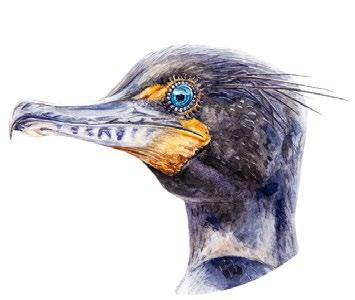
Bird beaks are uniquely suited to a bird’s particular habitat and diet. The shape of their beaks offer clues about both of these things. Birds eat anything from fruit and seeds to insects to small animals. There are birds that live high in the trees and birds that live on the ground. The size and shape of their beaks are adapted to their specific needs. Hummingbirds have long, slender beaks that allow them to suck the nectar from inside a flower. Predatory birds like hawks have big, hooked beaks used for tearing apart small animals. Waterfowl have broad, flat bills used for straining food from water. Birds that eat seeds and nuts have short, cone-shaped beaks.

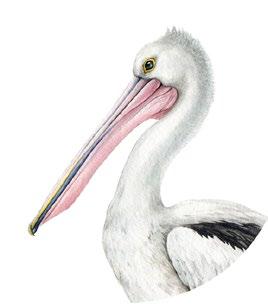
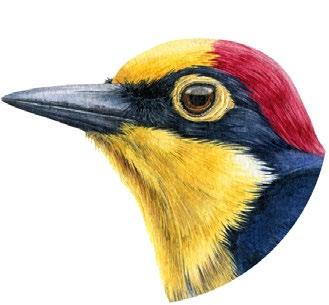

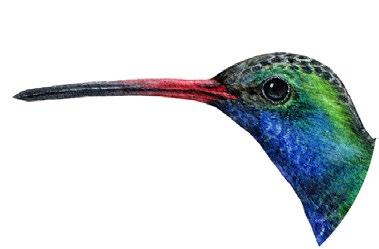
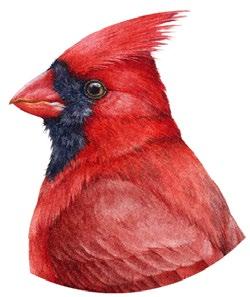
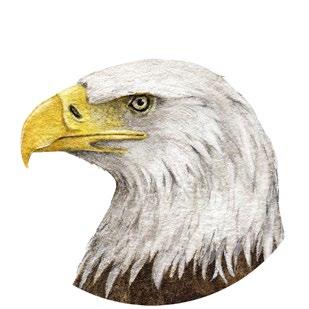

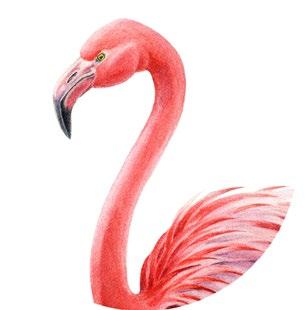
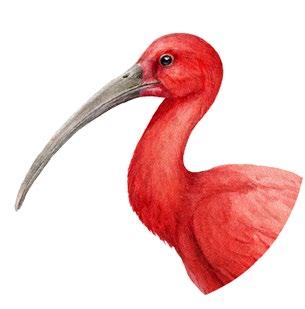
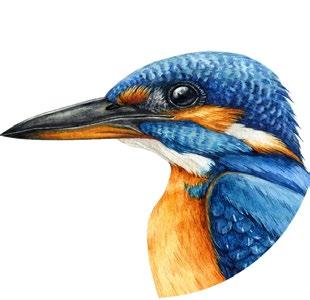
The chart to the right shows a variety of birds along with the way they typically eat. Notice how one bird's beak is different from the next? The distinct beak shapes tell us a lot about how (and what) each bird eats. A filter-feeding bird will not be able to draw nectar from a flower, and a hummingbird will not be able to pry open a seed.
WHICH CAME FIRST: THE CHICKEN OR THE EGG?
Birds are egg laying animals. Though all birds lay eggs, all animals that lay eggs are not birds. Laying eggs is something birds have in common with amphibians, fish and reptiles. Most birds lay their eggs in nests, though some do not. Most birds incubate their eggs. Both male and female birds have a role in caring for the hatchlings in most bird species. A female bird can lay anywhere from one to 20 eggs at a time. All eggs laid at one time are called a clutch of eggs.
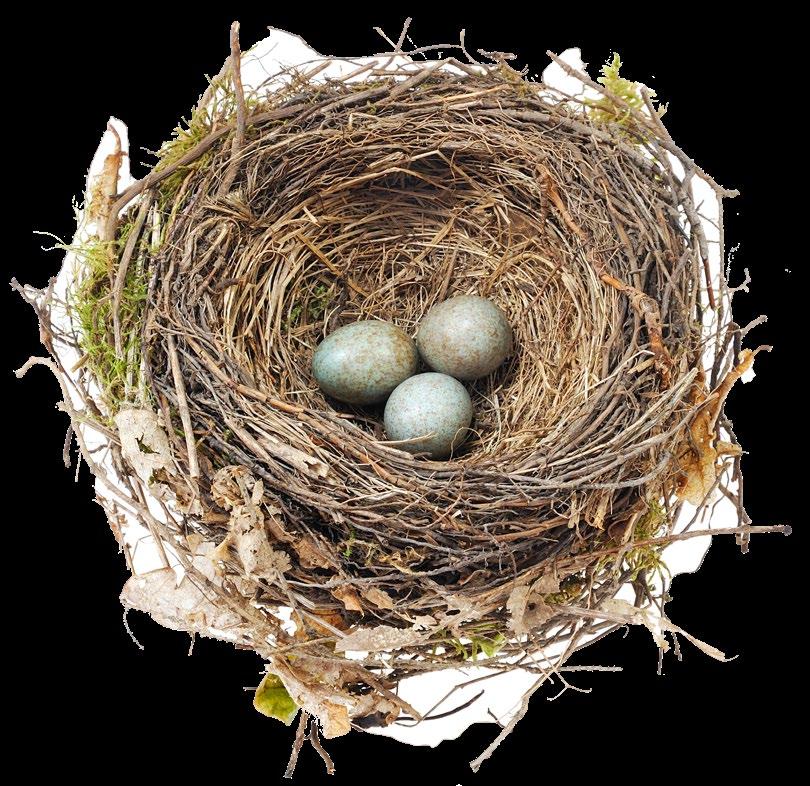
37
Aerial fishing
Pursuit fishing
Probing Filter feeding
Scavenging
Raptorial
Grain eating Nectar feeding
Fruit eating Chiseling
Dip netting
Surface skimming
A clutch of eggs inside a bird's nest
ALABAMA WILDLIFE
Alabama Course of Study Standards
SC15.K.3 SC15.2.7 SC15.3.10 SC15.3.11 SC15.3.12
National Standards
NS.K-4.3
OBJECTIVE
By completing this activity, students will learn how to:
• Identify how the impacts on habitat affect the survival of an organism
• Identify endangered and extinct species in Alabama
MATERIALS
For this activity, you will need the following items:
• Access to technology or teacher-provided information/ books for research
• A poster template that can be provided as a handout or technology that allows students to digitally create posters
PROCEDURE
To complete this activity, follow these steps:
1. As a class, watch the video linked below.
X Extinct and Endangered Animals for Kids
2. After watching the video, read/review the article linked below.
X Alabama Today: "Alabama has the third most endangered animal species"
3. As a class, review what you have learned about endangered and extinct species. Discuss the impact of habitat destruction, predator/prey relationships and limiting factors on wildlife populations.
suggested discussion questions
• What is an endangered species?
Provide examples of endangered species in Alabama.
• What is an extinct species?
Provide examples of extinct species in Alabama.
• What can we do to help save animals from becoming endangered and extinct?
4. Read/review the articles linked below. As you are reading, you may want to create a list of threatened, endangered and extinct species specific to Alabama for your students.
X Environmental Conservation Online System (Alabama)
X AL .com: "7 more Alabama species now considered extinct, wildlife officials say"
X Outdoor Alabama: Red Wolf
5. Have students (individually or in pairs) choose one of the threatened, endangered or extinct species from Alabama.
6. Students will investigate background information about their chosen species.
7. Using the information from the background research, and the poster template (right), have students create a “Have You Seen Me?” poster with the following details and information:
• Picture of the animal
Pictures can be drawn by hand, cut and pasted from a secondary source or, if the appropriate technology is available, digitally inserted.
• Name of the animal
• Description of the animal's habitat
• Description of the animal's diet and role in the food chain
• Description of the animal's status as threatened, endangered or extinct
38
Have You Seen Me?
In the space below, draw or paste photos of the animal you have researched.
What is the name of your animal?
Where does your animal live in Alabama? What type of habitat does it like?
What does your animal eat?
Is your animal a predator? If not, is it prey? What other animals, if any, hunt your animal?
Is your animal threatened, endangered or extinct? Why?
Name Date
ALABAMA WILDLIFE
Alabama Course of Study Standards
SC15.3.3 SC15.3.5 SC15.3.8
National Standards
NS.K-4.3
OBJECTIVE
By completing this activity, students will learn how to:
• Describe different types of bird beaks
• Explain how each beak is adapted to feed on different foods in various environments
MATERIALS
For this activity, you will need the following items:
• "Fill the Bill" worksheet
• Pencils
• Three (3) eye droppers or straws
• Four (4) pairs of chopsticks
• Three (3) nutcrackers or pairs of pliers
• Two (2) large scoops or slotted spoons
• Three (3) strainers
• Three (3) envelopes or small fishnets
• Three (3) sets of tweezers
• Three (3) tongs
• Small log
• Popcorn or small marshmallows
• Rice and puffed rice
• Two (2) aquariums or large bowls
• Gummy worms
• Oatmeal
• Stemmed cherries or cotton balls
• A tall, narrow vase
• Large saucepan
• Walnuts or other nuts
• Dried macaroni or Styrofoam chunks
• String
PROCEDURE
To complete this activity, follow these steps:
1. Review the "Birds & Their Beaks" lesson on page 23. Use the bird beaks graphic (right) as a reference.
2. As a class, talk about the different types of birds and beaks. Discuss how the different types of beaks help birds survive in their habitats.
suggested discussion points
• Hummingbirds have long, hollow beaks that they use to probe flowers for nectar. The beak protects the tongue which slurps up the nectar.
• Curlew, godwits, kiwis and snipes have very long beaks that they use to probe for worms, crustaceans and other small creatures in mud and water.
• Cardinals, sparrows, grosbeaks and other finch-like birds have very short, conical beaks. The beaks are very strong and can break even tough seeds.
• Spoonbills and pelicans have long, flattened or pouchlike beaks that they use to scoop up fish and other aquatic creatures.
• Flamingos and some ducks have bills that act like strainers to filter tiny plants and animals from the water. (Only certain kinds of ducks are filter feeders.)
• Nighthawks, whip-poor-wills, swifts and swallows have large, gaping mouths that act like nets to trap insects. These birds catch insects on the wing.
• Warblers have small, sharp, pointed beaks for eating insects from leaves, twigs and logs.
• Toucans have very long, thick beaks for reaching out and plucking fruit from trees.
3. Collect all the materials for the activity.
40
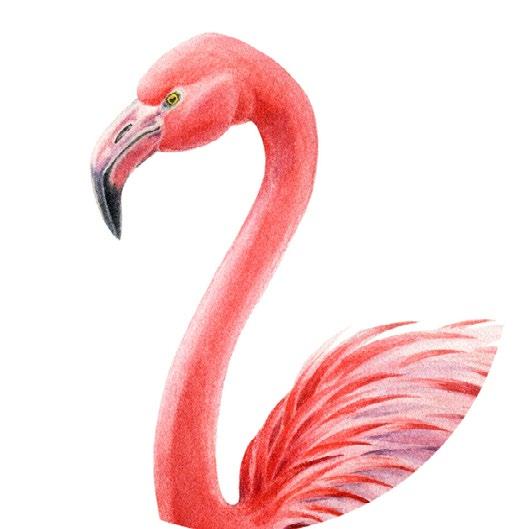
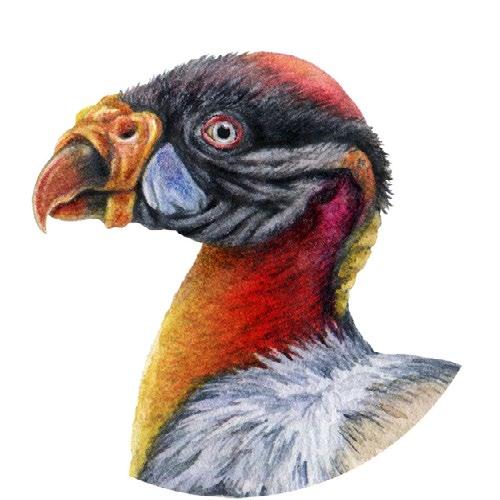
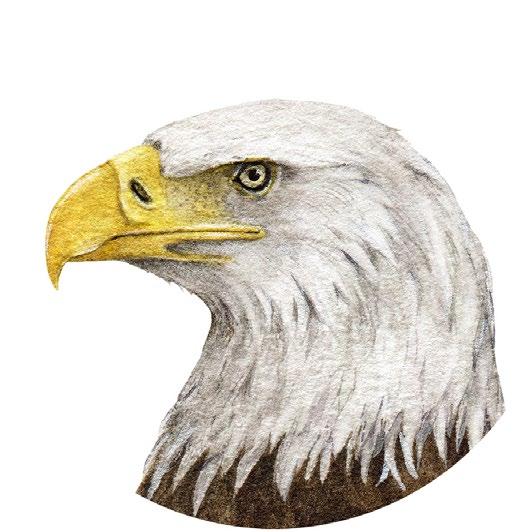

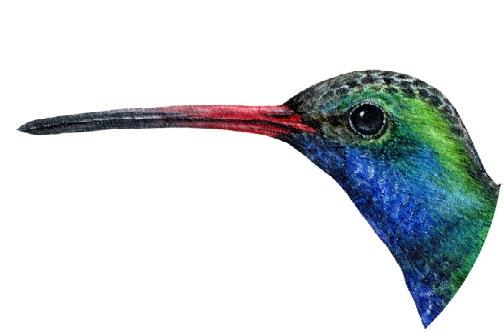
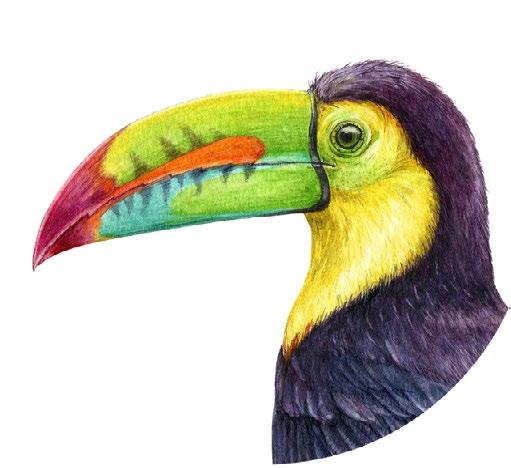

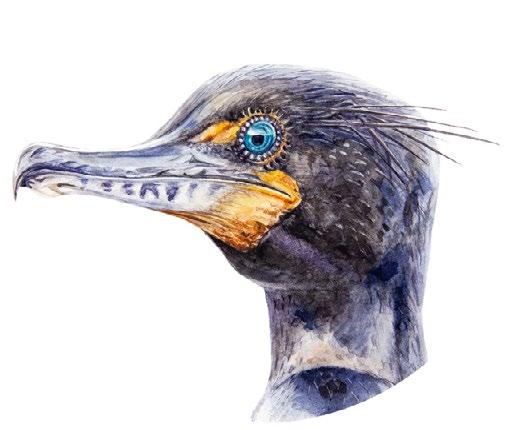


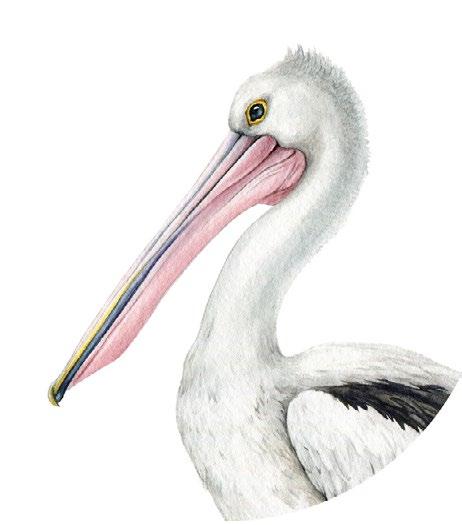

41
Grain eating
Nectar feeding
Fruit eating
Chiseling
Dip netting
Surface skimming
Aerial fishing
Pursuit fishing
Probing
Filter feeding
Scaveging
Raptorial
4. Set up eight different stations as outlined below. Each station will feature items that represent a different type of bird beak and a type of food commonly eaten with that beak. At each station, place three different tools—one that is correct for the type of food and two that are not. Have signs that identify the type of food represented in each station, e.g., worms in mud, nectar, fruit, etc.
station one
Water in a tall, thin vase to represent nectar in a flower. Tools should include an eyedropper or straw, an envelope or small fishnet, and a large scoop or slotted spoon.
Bird represented: Hummingbird
station two
Fake worms or grapes covered with dry oatmeal in a saucepan to represent worms buried in the mud. Tools should include chopsticks, a nutcracker or pair of pliers, and a strainer.
Bird represented: Snipe
station three
Whole walnuts or other nuts to represent seeds with hard coverings. Tools should include a nutcracker or pair of pliers, tongs and chopsticks.
Bird represented: Cardinal
station four
Bits and chunks of Styrofoam floating in a water-filled aquarium or large bowl to represent fish and other aquatic animals. Tools should include a large scoop or slotted spoon, an eyedropper or straw, and chopsticks.
Bird represented: Pelican
station five
Puffed rice floating in a water-filled aquarium or large bowl to represent tiny aquatic plants and animals. Tools should include strainer, forceps or tweezers, and tongs.
Bird represented: Duck
station six
Popcorn or tiny marshmallows tossed in the air (which must be caught while in the air) to represent flying insects. Tools should include an envelope or small fishnet, forceps or tweezers, and chopsticks.
Bird represented: Whip-poor-will
station seven
Rice spread on a log or thick stick to represent caterpillars and other insects. Tools should include forceps or tweezers, an envelope or small fishnet, and a nutcracker or pair of pliers.
Bird represented: Warbler
station eight
Cherries hanging from a string by their stems to represent fruit hanging from a branch. Tools should include tongs, an eyedropper or straw, and a strainer.
Bird represented: Toucan
5. Divide the class into eight groups and place each group at a different station.
6. Distribute the "Fill the Bill" worksheet (right).
7. Explain that each station features an item that represents foods a bird would eat as well as three different tools. Each tool represents a type of bird beak and function. The groups must decide which tool would most efficiently gather the food item at each station by trying each tool. Once they select the best tool, students should write the name of the tool next to the correct station in the top section of their worksheet. Provide a time limit for students at each station in order to keep the groups moving. Also, allow time for you or the groups to reset their stations for the next group. For example, be sure to recover or refill any food items that may have
8. Underneath the squares are pictures of different birds and their beaks. On the line under each picture, they should write the number of the square that repre- sents the correct beak. For example, they should write “8” on the line under the toucan.
9. Review answers on worksheet.
10. Discuss beak adaptations in general. Explain that many birds, after millions and millions of generations, have evolved very specialized beaks (beaks that can eat only one certain type of food). Ask the group how specialized beaks can help some birds stay alive. (A bird with a specialized beak can often eat a type of food that no other bird can eat.) Then ask how a specialized beak might hurt a bird.
11. (If the bird’s habitat changes and its food is no longer available, the bird might die because it can’t eat anything else.) Explain that some birds, such as crows, have very versatile beaks which allow them to eat fruits, nuts, berries, dead animals, and even fish and small rodents.
42
Fill the Bill
Write the name of the tool that worked best at each station listed below.
The tools used at each station were meant to represent different types of bird beaks. Take a close look at the photos below. Write the station number that best represents the bird shown.
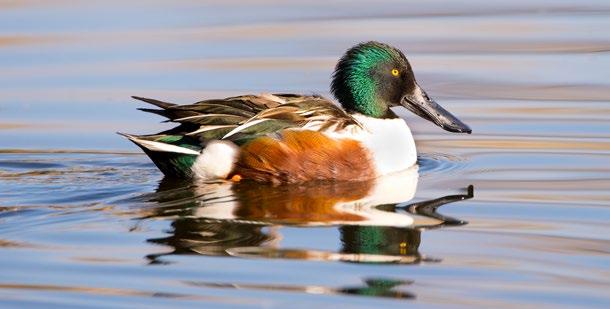

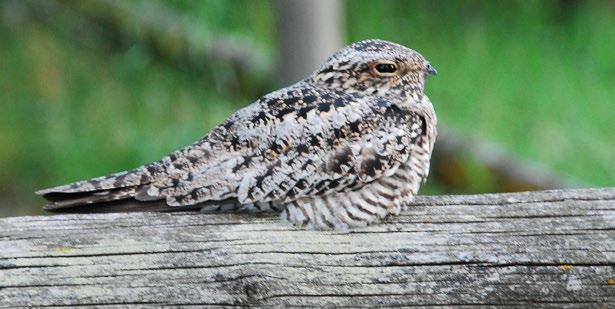




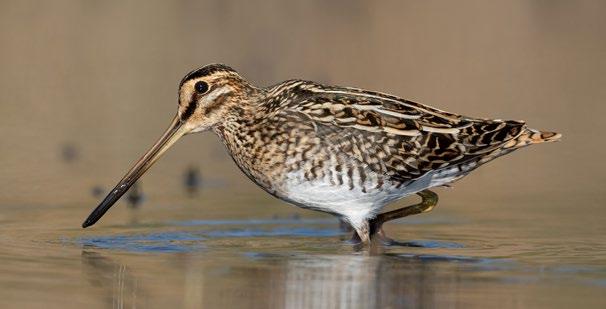
Name Date
station one station two station three station four station five station six station seven station eight
Snipe station Cardinal Toucan Pelican Hummingbird Whip-poor-will Warbler Duck station station station station station station station
What to do after the show
After seeing Peter and the Wolf, guide students in a discussion about the experience. Included in this section are some postperformance activities you can share with your students.

1. Discuss the music in Peter and the Wolf. suggested discussion questions
• Do you think the instruments sounded like the characters they were meant to represent?
2. Discuss the story and characters in Peter and the Wolf. suggested discussion questions
• Who was your favorite character? Why?
• Did the story teach any lessons? (stranger danger, obeying your parents, courageousness)
3. Discuss character traits exhibited in Peter and the Wolf suggested discussion question s
• Was Peter trustworthy? Was Grandfather? Explain.
• Did Peter take responsibility? Did the bird? How about Grandfather? For what (or whom) did they take responsibility? How?
• Which characters demonstrated care for others? How?
• Did any of the characters show courage? Explain.
4. Distribute the "My Trip to the Gogue Center" and "Who's Who: Peter and the Wolf" worksheets on the following pages. Once complete, have students share their responses.
44
Date
My Trip to the Gogue Center
Answer these questions about the performance and your visit to the Gogue Center.
List three things you remember hearing or seeing during the performance of Peter and the Wolf .
Name something you learned during the performance.
Name something from the performance you would like to know more about.
If you could ask a member of the Alabama Symphony Orchestra a question, what would you ask?
In the space below, draw something special you remember hearing or seeing during the performance.
Name
1.
2.
3.
Date
Who's Who: Peter and the Wolf
Use the chart below to recall the characters you met in Peter and the Wolf .
Character
Character Traits
How did this character behave in the performance?
Instrument
What instrument(s) represented this character?
How did the music make you feel about this character? Bird
Name
Duck Cat Peter Grandfather Wolf
The Hunters
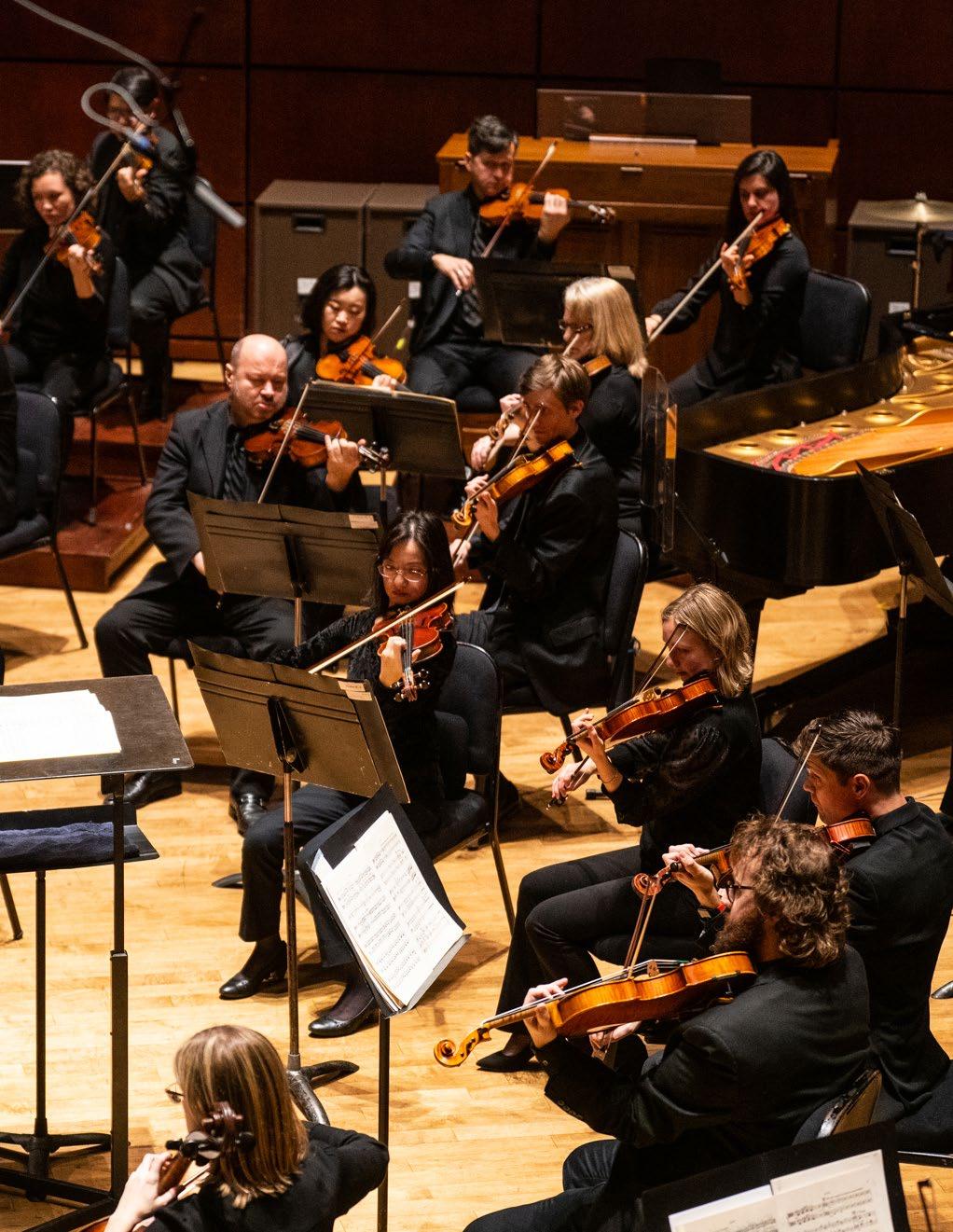
47
Alabama Symphony Orchestra
Online resources
If you would like to continue to learn and explore, here are some resources that might be helpful.
Alabama Symphony Orchestra
X https://alabamasymphony.org/uploads/general/1819-YPCreduced.pdf
Peter and the Wolf Study Guide
Eulenspiegel Puppet Theatre; University of Dubuque
X https://www.dbq.edu/media/FineArts/HeritageCenter/ LiveattheHeritageCenter/PETER-AND-THE-WOLFSTUDY-GUIDE.pdf
Peter and the Wolf Study Guide
Queensland Symphony Orchestra
X https://qso.com.au/uploads/regional_peter_and_the_wolf.pdf
Meet the Families
Benjamin Britten’s The Young Person’s Guide to the Orchestra San Francisco Symphony
X http://www.keepingscore.org/sites/default/files/ lessonplans/KSEd_Meet_the_Families_Redfern.pdf
Instruments of the Orchestra
San Francisco Symphony
X https://www.sfsymphony.org/EducationCommunity/ Music-Connects-Kids/Instruments-of-the-Orchestra
Fairy Tale Story Mapping
Alabama Learning Exchange
X https://alex.asc.edu/learningasset_view.php?asset_ id=2456&res_id=2456&res_type=LA
Common Birds of Alabama
Alabama Birding Exchange
X https://alabamabirdingtrails.com/common-birds-alabama
Birds: Different Types, Definitions, Photos, and More
AZ Animals
X https://a-z-animals.com/animals/birds
Fill the Bill: Alabama Outdoor Classroom Activity alabamawildlife.org
X https://www.alabamawildlife.org/uploadedFiles/File/ Outdoor_Classroom_Activity_FillTheBill_35.pdf
48
The Jay and Susie Gogue Performing Arts Center at Auburn University serves students and educators across the state of Alabama and beyond with its annual K–12 School Performance Series.
These high-quality and transformative arts experiences are further enriched with performance study guides that provide meaningful cross-curricular connections.
Developed by our Department of Education and Engagement, in collaboration with the Gogue Center Curriculum Council, each performance study guide contains information about the featured performing artist(s) or company, the art form, and relevant, grade-appropriate lessons and activities designed to help incorporate academic and arts standards into the classroom.
Our sincerest thanks to the members of the 2023–24 Gogue Center Curriculum Council.
2023–24 Gogue Center Curriculum Council
Laurin Beard
Elementary Art
Lee-Scott Academy
Lee County Private Schools
Stacey Blakemore
Secondary ELA & Art
Oak Mountain High School
Shelby County Schools
Abbie Gaston Elementary (3–5)
Creekside Elementary School
Auburn City Schools
Dr. Rebecca Hendrix
Elementary Enrichment Specialist
Retired
Opelika City Schools
Kewana Long
Kindergarten
Vaughn Road Elementary School
Montgomery County Schools
Anna Mungenast Math
Lee-Scott Academy
Lee County Private Schools
Alison Starr
Science
Lee-Scott Academy
Lee County Private Schools
Mary Elise Thornton
Secondary ELA
Booker T. Washington High School
Montgomery County Schools
Dr. Marcia Webb
Elementary Enrichment Specialist/Adjunct Professor
Retired/Auburn University
Auburn City Schools
49
K–12 School Performance Sponsors
Myrna Walker
The Schneller Family
The Care Foundation of BCBS of Alabama
Artist Engagement Sponsors
Catherine & Lester Killebrew
2023–24 Season Sponsors
Walt & Ginger Woltosz
GOGUECENTER.AUBURN.EDU
GOGUECENTER.AUBURN.EDU/EDUCATION


 Alabama Symphony Orchestra
Alabama Symphony Orchestra
 The Jay and Susie Gogue Performing Arts Center at Auburn University
The Jay and Susie Gogue Performing Arts Center at Auburn University
 Walter Stanley and Virginia Katharyne Evans Woltosz Theatre
Walter Stanley and Virginia Katharyne Evans Woltosz Theatre



 Alabama Symphony Orchestra
Alabama Symphony Orchestra





















































